目录
视频:
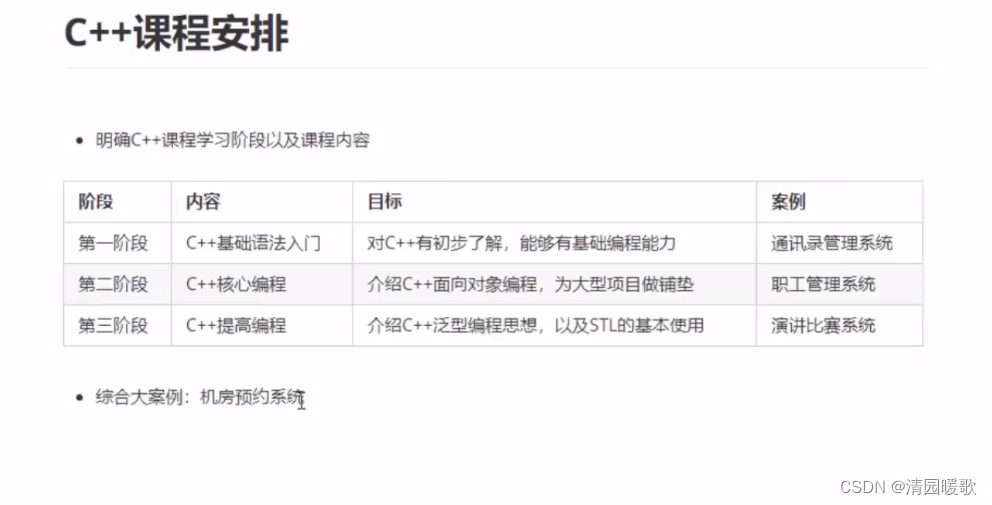
ctrl + k +c :多行注释
ctrl + k +u :解注释
一、C++初识
1.1 第一个C++程序

#include<iostream>
using namespace std;
int main()
{
cout << "hello world" << endl;
system("pause");
return 0;
}
1.2 注释

#include<iostream>
using namespace std;
// 1、单行注释
/*
2、多行注释
*/
int main()
{
// 输出 hello world
cout << "hello world" << endl;
system("pause");
return 0;
}1.3 变量
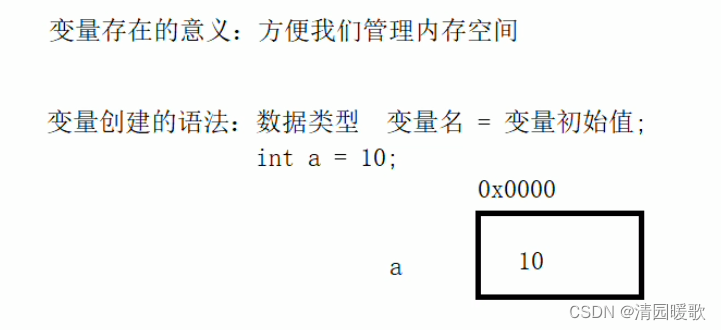
#include<iostream>
using namespace std;
int main()
{
int a = 10;
cout << "a = " << a << endl;
system("pause");
return 0;
}1.4 常量

#include<iostream>
using namespace std;
// 常量的定义方式
/*
1、#define 宏常量
2、const修饰的变量
*/
// 1、define
#define Day 7
int main()
{
// Day = 14; // 会报错
cout << "一周总共有:" << Day << "天" << endl;
// 2、const
const int month = 12;
// month = 24; // 错误,constx修饰的变量也成为常量
cout << "一年总共有:" << month << "个月份" << endl;
system("pause");
return 0;
}1.5 关键字

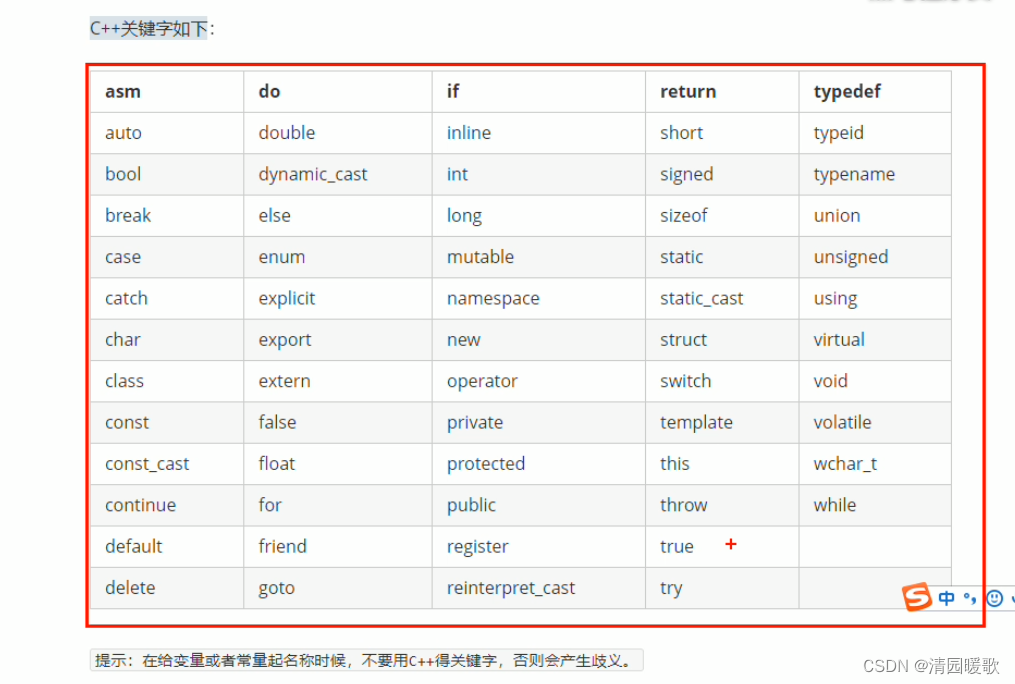
#include<iostream>
using namespace std;
int main()
{
// 创建变量:数据类型 变量名称 = 变量初始值
// 不要用关键子给变量或常量起名称
int a = 10;
cout << "hello world" << endl;
system("pause");
return 0;
}1.6 标识符命名规则

#include<iostream>
using namespace std;
// 标识符命名规则
// 1、标识符b不可以是关键字
// 2、标识符是由字母、数字、下划线构成
// 3、标识符第一个字符只能是字符或下划线
// 4、标识符是区分大小写的
int main()
{
// 1、
//int int = 10;
// 2、
int abc = 10;
int _abc = 20;
int _123abc = 30;
// 3、
// int 123abc = 40;
// 4、
int aaa = 100;
cout << aaa << endl;
// cout << AAA << endl; // aaa 和 AAA 不同
// 建议:给变量起名的时候,最好能够做到见名知意
int num1 = 10;
int num2 = 20;
int sum = num1 + num2;
cout << sum << endl;
cout << "hello world" << endl;
system("pause");
return 0;
}二、数据类型
2.1 整型
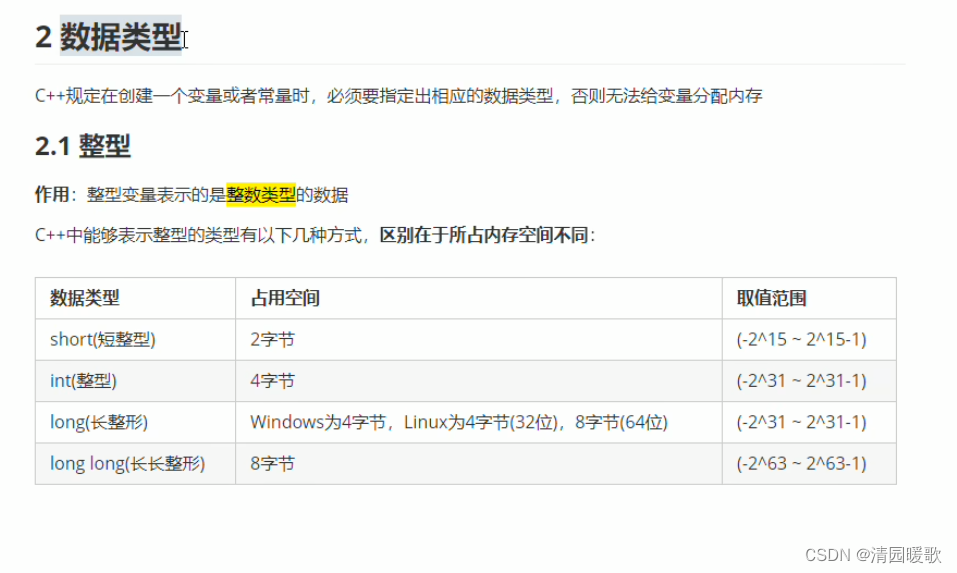

#include<iostream>
using namespace std;
int main()
{
// 整型
// 1、短整型(-32768 ~ 32767)
short num1 = 10;
// short num1 = 32768; // 输出是 -32768
// 2、整型
int num2 = 20;
// 3、长整型
long num3 = 30;
// 4、长长整型
long long num4 = 40;
cout << "num1 = " << num1 << endl;
cout << "num2 = " << num2 << endl;
cout << "num3 = " << num3 << endl;
cout << "num4 = " << num4 << endl;
system("pause");
return 0;
}
2.2 sizeof 关键字

#include<iostream>
using namespace std;
int main()
{
// 整型:short (2) int (4) long (4) long long (8)
// 可以利用sizeof求出数据类型占用内存大小
// 语法: sizeof(数据类型/变量)
short num1 = 10;
cout << "num1占用内存空间:" << sizeof(num1) << endl;
cout << "short占用内存空间:" << sizeof(short) << endl;
int num2 = 10;
cout << "num2占用内存空间:" << sizeof(num2) << endl;
cout << "int占用内存空间:" << sizeof(int) << endl;
long num3 = 10;
cout << "num3占用内存空间:" << sizeof(num3) << endl;
cout << "long占用内存空间:" << sizeof(long) << endl;
long long num4 = 10;
cout << "num4占用内存空间:" << sizeof(num4) << endl;
cout << "long long占用内存空间:" << sizeof(long long) << endl;
// 整型大小比较
// short < int <= long <= long long
system("pause");
return 0;
}
2.3 实型(浮点型)
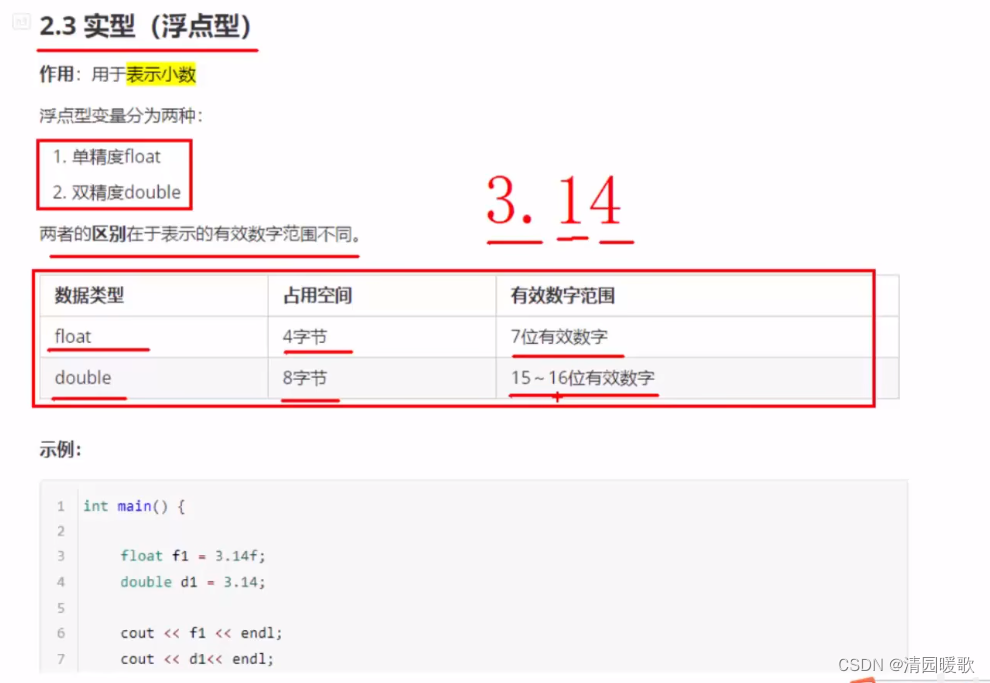
#include<iostream>
using namespace std;
int main()
{
// 1、单精度 float
// 2、双精度 double
// 默认情况下 输出一个小数,会显示出6位有效数字
float f1 = 3.1415926f; // float f1 = 3.14 的话3.14会默认当作 double,再转成 float
cout << "f1 = " << f1 << endl;
double d1 = 3.1415926;
cout << "d1 = " << d1 << endl;
// 统计 float 和 double 占用内存空间
cout << "float 占用内存空间为:" << sizeof(float) << endl; // 4字节
cout << "double 占用内存空间为:" << sizeof(double) << endl; // 8字节
// 科学计数法
float f2 = 3e2; // 3*10^2
cout << "f2 = " << f2 << endl;
float f3 = 3e-2; // 3*0.1^2
cout << "f3 = " << f3 << endl;
system("pause");
return 0;
}
2.4 字符型

#include<iostream>
using namespace std;
int main()
{
// 1、字符型变量创建方式
char ch = 'a';
cout << ch << endl;
// 2、字符型变量所占内存大小
cout << "sizeof(char):" << sizeof(char) << endl;
// 3、字符型变量常见错误
// char ch2 = "b"; // 不能用双引号
// char ch2 = 'abcdef' // 创建字符型变量单引号内只能有一个字符
// 4、字符型变量对应 ASCII 编码
// a - 97
// A - 65
cout << (int)ch << endl;
system("pause");
return 0;
}

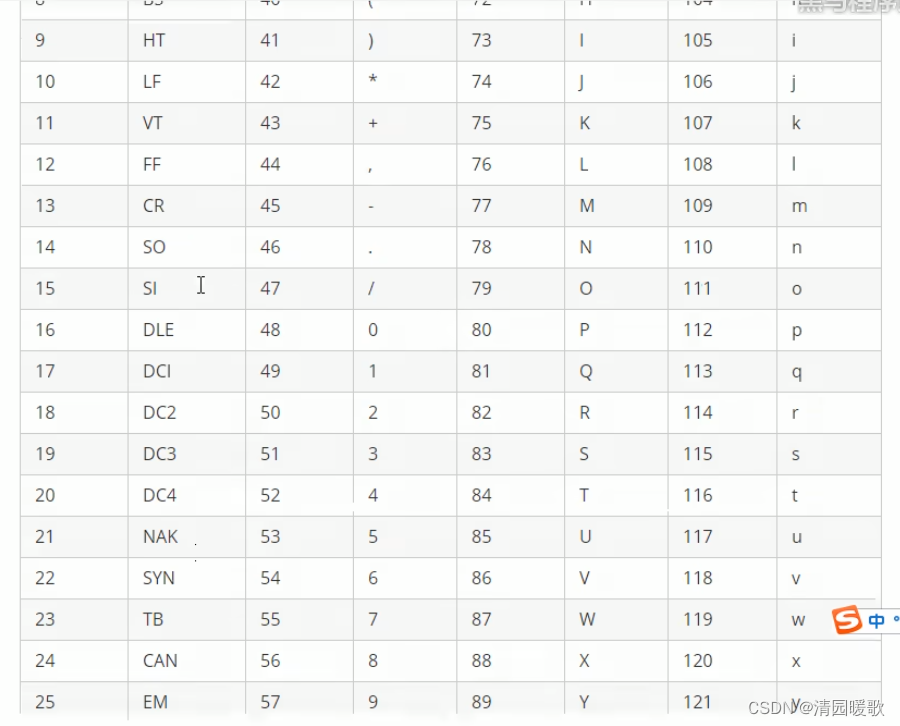
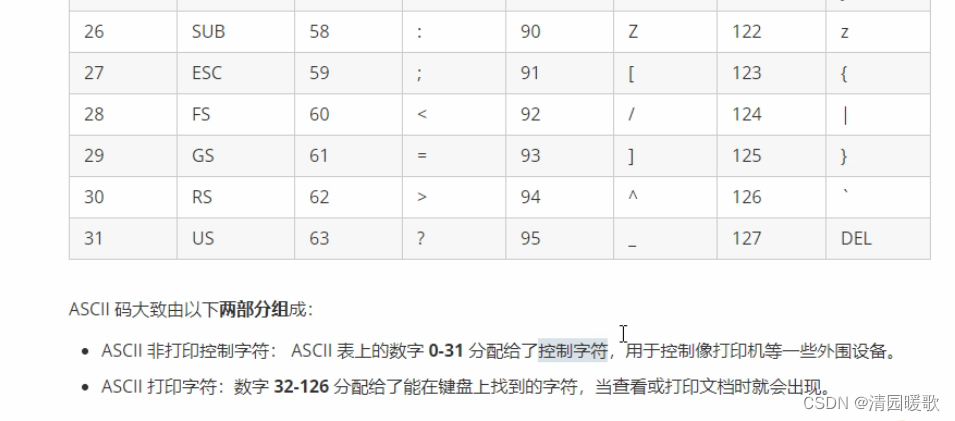
2.5 转义字符
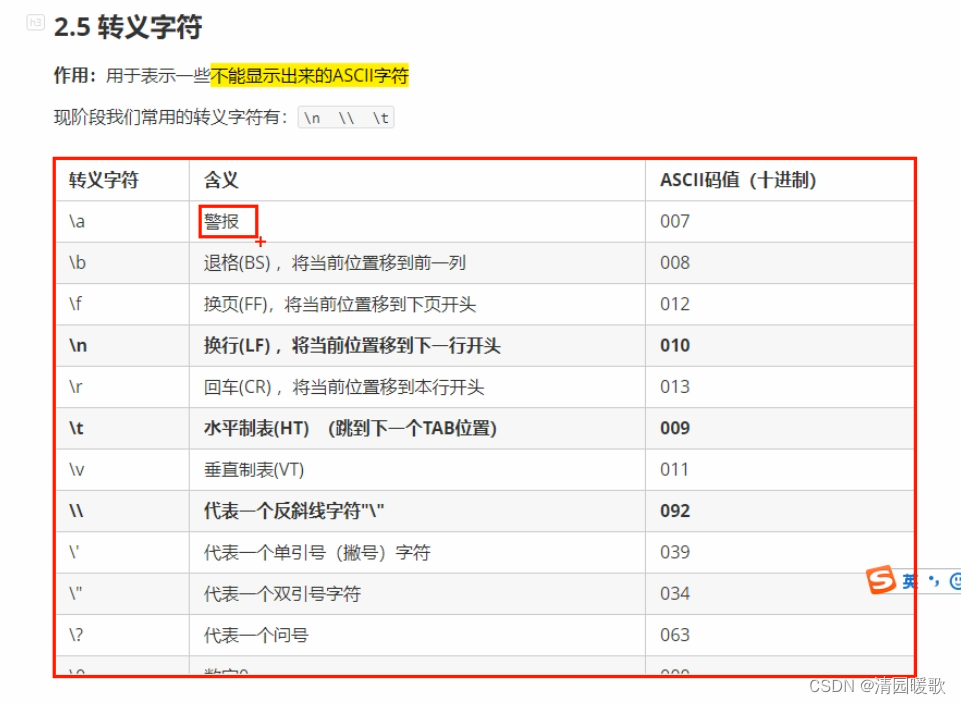
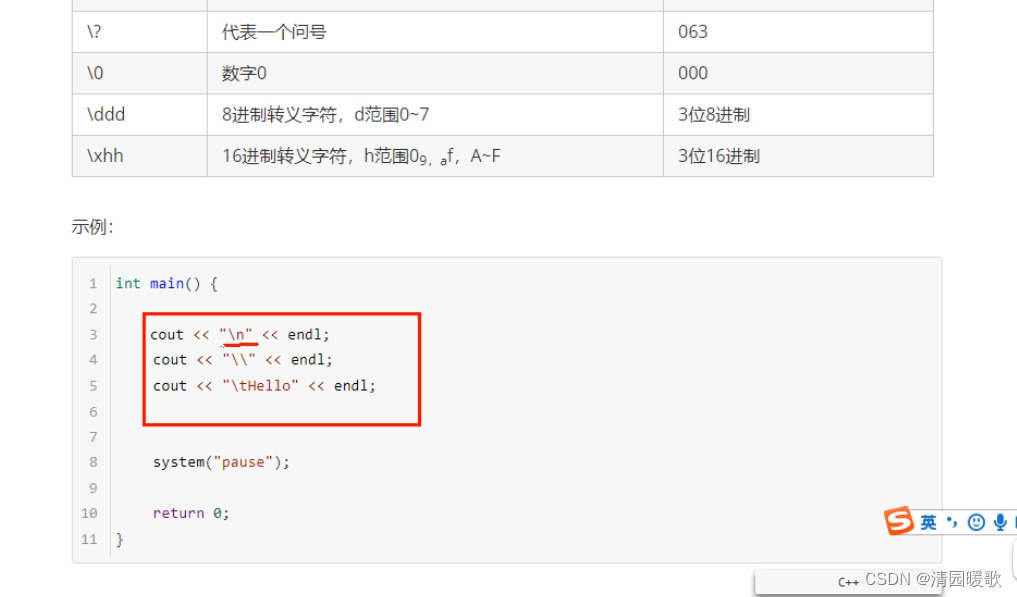
#include<iostream>
using namespace std;
int main()
{
// 转义字符
// 换行符 \n
cout << "hello world\n" << endl;
// 反斜杠 \\
cout << "\\" << endl;
// 水平制表符 \t
cout << "aaa\thello world" << endl;
cout << "a\thello world" << endl;
cout << "aaaaa\thello world" << endl;
// \t 占了4个位置,有3个a,后面就有5个空格
// 最大用处:输出对齐
system("pause");
return 0;
}
2.6 字符串型

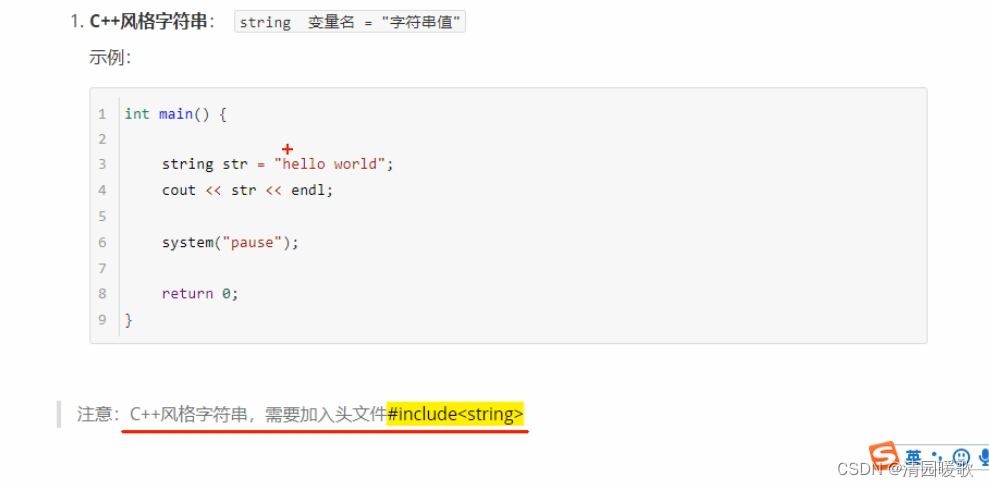
#include<iostream>
using namespace std;
#include <string> // 用C++风格字符串的时候,要包含这个头文件
int main()
{
// 1、C风格字符串
// 注意事项 char 字符串名 []
// 注意事项2 等号后面 要用双引号 包含起来字符串
char str[] = "hello world";
cout << str << endl;
cout << "hello world" << endl;
// 2、C++风格字符串
// 包含一个头文件 #include <string>
string str2 = "hello world";
cout << str2 << endl;
system("pause");
return 0;
}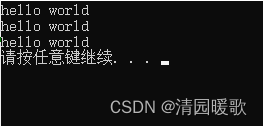
2.7 布尔类型 bool

#include<iostream>
using namespace std;
#include <string> // 用C++风格字符串的时候,要包含这个头文件
int main()
{
// 1、创建bool数据类型
bool flag = true; // true代表真
cout << flag << endl;
flag = false; // false代表假
cout << flag << endl;
// 本质上 1代表真 0代表假
// 2、查看bool类型所占内存空间
cout << "bool类型所占内存空间:" << sizeof(bool) << endl;
system("pause");
return 0;
}
2.8 数据的输入

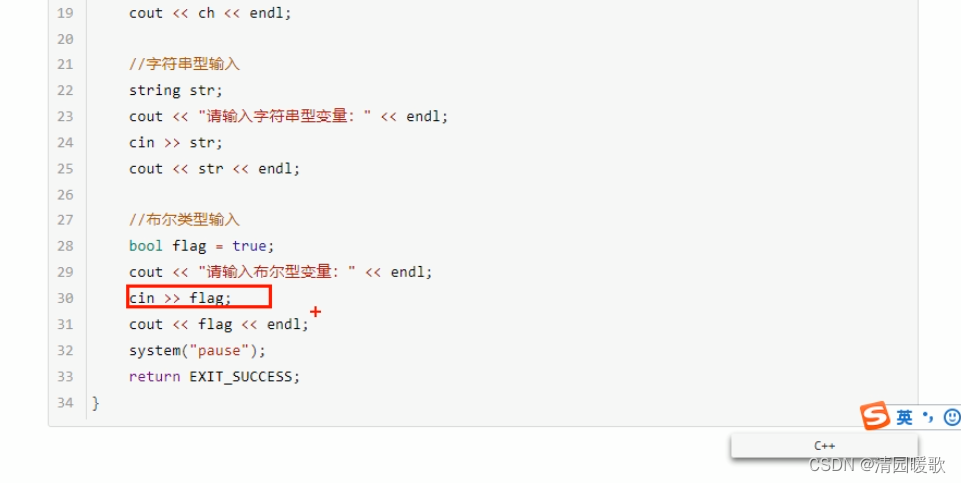
#include<iostream>
using namespace std;
#include <string> // 用C++风格字符串的时候,要包含这个头文件
int main()
{
// 1、整型
/*int a = 0;
cout << "请给整型变量a赋值:" << endl;
cin >> a;
cout << "整型变量a = " << a << endl;*/
// 2、浮点型
/*float f = 3.14f;
cout << "请给浮点型变量f赋值:" << endl;
cin >> f;
cout << "浮点型变量 f= " << f << endl;*/
// 3、字符型
/*char ch = 'a';
cout << "请给字符型变量ch赋值:" << endl;
cin >> ch;
cout << "字符型变量ch = " << ch << endl;*/
// 4、字符串类型
/*string str = "hello";
cout << "请给字符串str赋值:" << endl;
cin >> str;
cout << "字符串str = " << str << endl;*/
// 5、布尔类型
bool flag = false;
cout << "请给布尔类型 flag 赋值:" << endl;
cin >> flag; // bool类型 只要是非0的值都代表真
cout << "布尔类型flag = " << flag << endl;
system("pause");
return 0;
}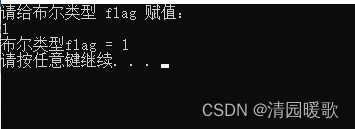
三、运算符

3.1 算术运算符

3.1.1 加减乘除运算
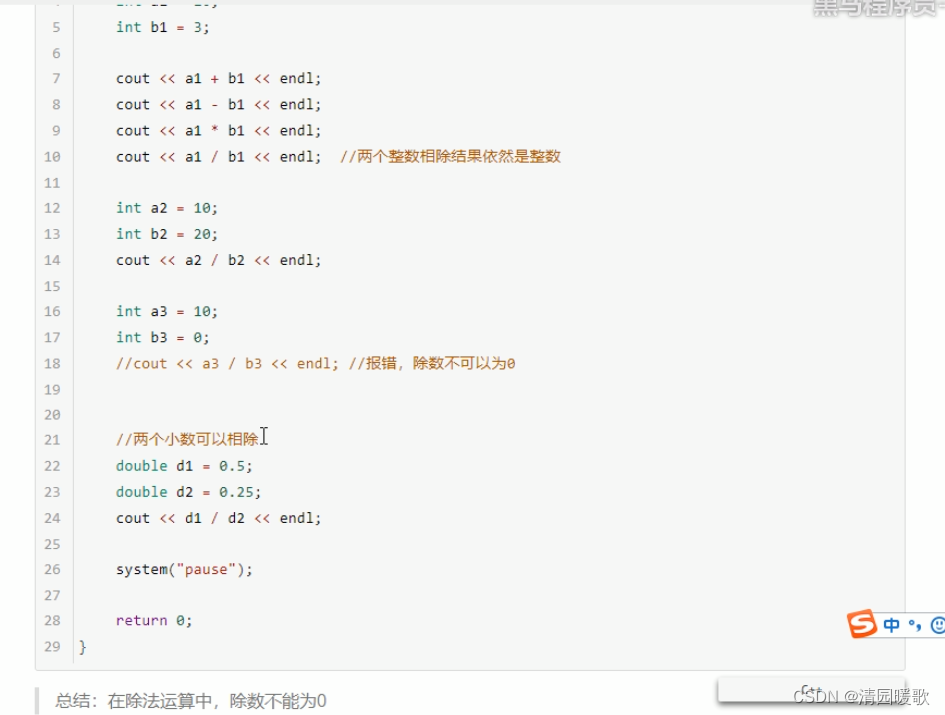
#include<iostream>
using namespace std;
int main()
{
// 加减乘除
int a1 = 10;
int b1 = 3;
cout << a1 + b1 << endl;
cout << a1 - b1 << endl;
cout << a1 * b1 << endl;
cout << a1 / b1 << endl; // 两个整数相除 结果依然是整数,将小数部分去除
int a2 = 10;
int b2 = 20;
cout << a2 / b2 << endl;
int a3 = 19;
int b3 = 0;
// cout << a3 / b3 << endl; // 会报错,除数不能是0
// 两个小数可以相除
double d1 = 0.5;
double d2 = 0.25;
cout << d1 / d2 << endl;
d1 = 0.5;
d2 = 0.22;
cout << d1 / d2 << endl;
system("pause");
return 0;
}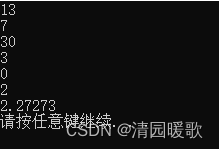
3.1.2 取模运算(%)
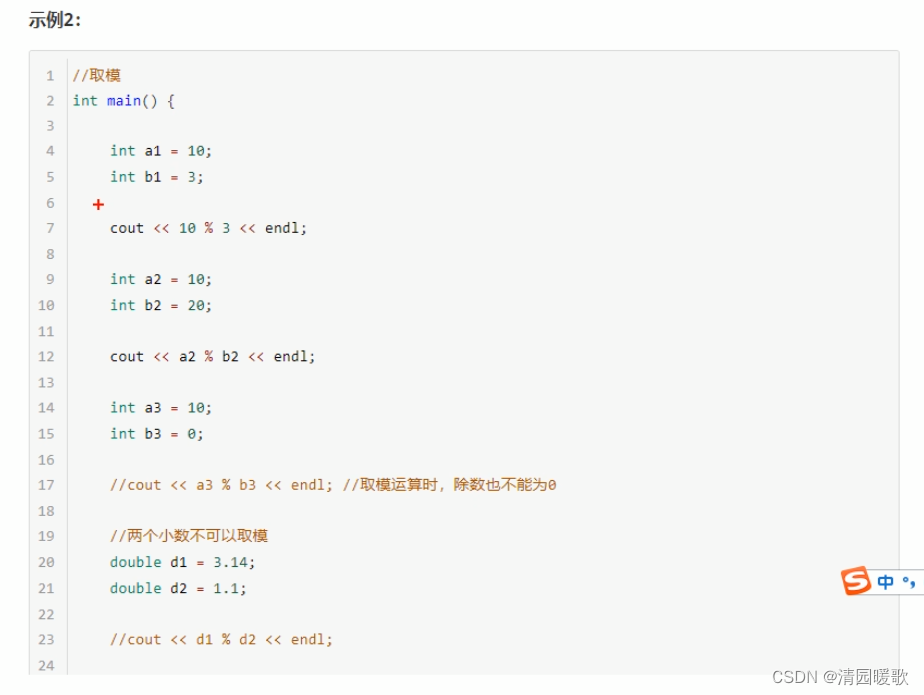
#include<iostream>
using namespace std;
int main()
{
int a1 = 10;
int b1 = 3;
cout << a1 % b1 << endl;
// 两个小数不可以做取模
double d1 = 3.14;
double d2 = 1.1;
// cout << d1 % d2 << enld;
system("pause");
return 0;
}
3.1.3 递增递减(++、--)


#include<iostream>
using namespace std;
int main()
{
// 1、前置递增
int a = 10;
++a; // 让变量+1
cout << "a:" << a << endl;
// 2、后置递增
int b = 10;
b++;
cout << "b:" << b << endl;
// 3、前置和后置
// 前置递增 先让+1,再进行表达式运算
int a2 = 10;
int b2 = ++a2 * 10;
cout << "a2=" << a2 << endl;
cout << "b2=" << b2 << endl;
// 后置递增 先进行表达式运算,再+1
int a3 = 10;
int b3 = a3++ * 10;
cout << "a3=" << a3 << endl;
cout << "b3=" << b3 << endl;
system("pause");
return 0;
}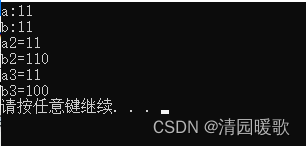
3.2 赋值运算符
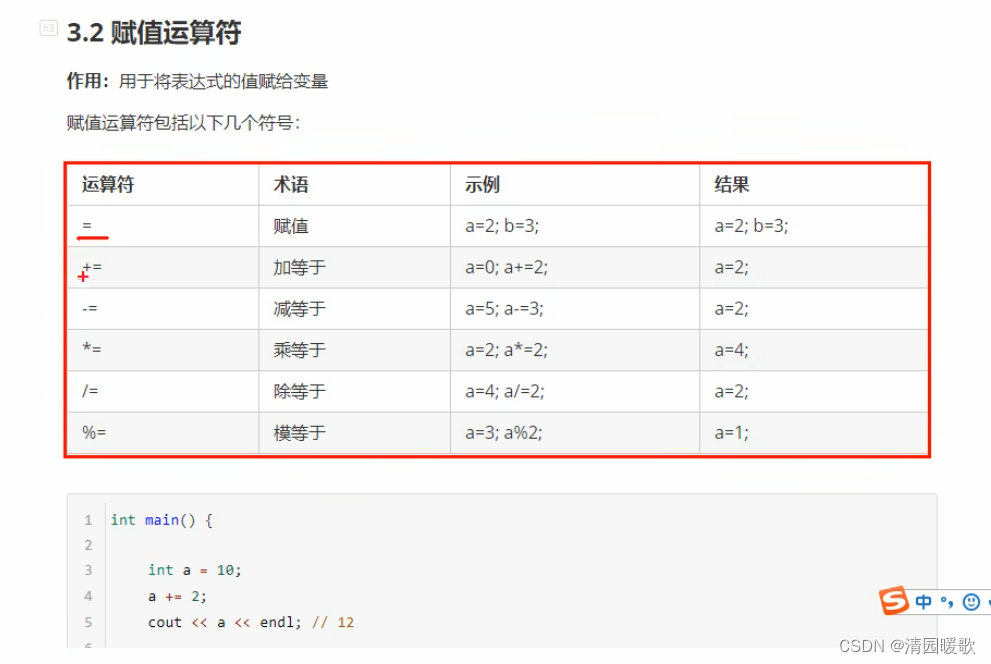
#include<iostream>
using namespace std;
int main()
{
// 赋值运算符
// =
int a = 10;
a = 100;
cout << "a = " << a << endl;
// +=
a = 10;
a += 2; // a = a += 2
cout << "a = " << a << endl;
// -=
a = 10;
a -= 2;
cout << "a = " << a << endl;
// *=
a = 10;
a *= 2;
cout << "a = " << a << endl;
// /=
a = 10;
a /= 2;
cout << "a = " << a << endl;
// %=
a = 10;
a %= 2;
cout << "a = " << a << endl;
system("pause");
return 0;
}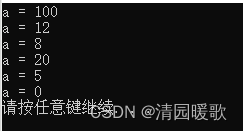
3.3 比较运算符
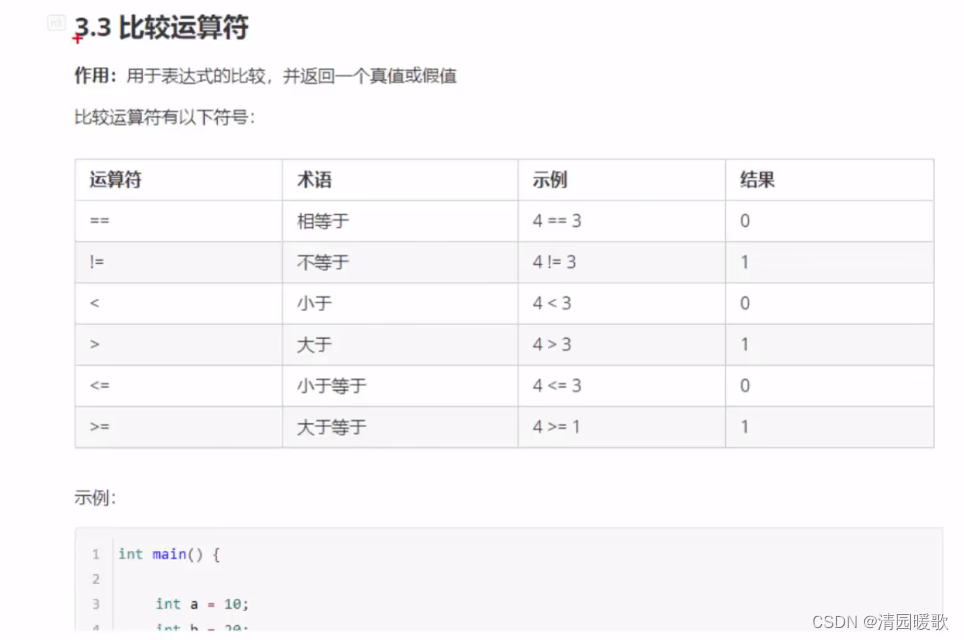
#include<iostream>
using namespace std;
int main()
{
// 比较运算符
// ==
int a = 10;
int b = 20;
cout << (a == b) << endl;
// !=
cout << (a != b) << endl;
// >
cout << (a > b) << endl;
// <
cout << (a < b) << endl;
// >=
cout << (a >= b) << endl;
// <=
cout << (a <= b) << endl;
system("pause");
return 0;
}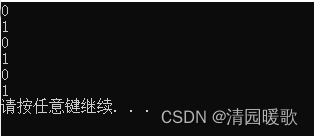
3.4 逻辑运算符

3.4.1 非(!)
#include<iostream>
using namespace std;
int main()
{
// 逻辑运算符 非 !
int a = 10;
// 在C++中,除了0都是真
cout << !a << endl;
cout << !!a << endl;
system("pause");
return 0;
}
3.4.2 与(&&)

#include<iostream>
using namespace std;
int main()
{
// 逻辑运算符 与 &&
int a = 10;
int b = 10;
cout << (a && b) << endl;
a = 0;
b = 10;
cout << (a && b) << endl;
system("pause");
return 0;
}
3.4.3 或(||)

#include<iostream>
using namespace std;
int main()
{
// 逻辑运算符 与 &&
int a = 10;
int b = 10;
cout << (a || b) << endl;
a = 0;
b = 10;
cout << (a || b) << endl;
a = 0;
b = 0;
cout << (a || b) << endl;
system("pause");
return 0;
}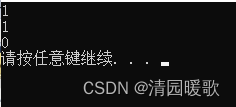
四、程序流程结构

4.1 选择结构
4.1.1 单行 if 语句
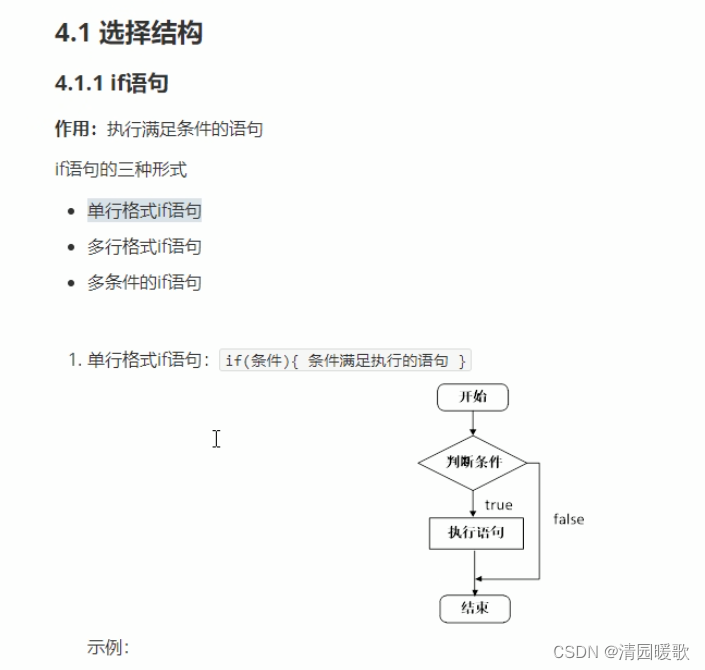
#include<iostream>
using namespace std;
int main()
{
// 选择结构 单行if语句
// 输入分数,大于600,就输出
// 1、用户输入分数
int score = 0;
cout << "请输入您的分数:" << endl;
cin >> score;
// 2、打印用户输入的分数
cout << "您输入的分数为:" << score << endl;
// 3、判断分数是否大于600,大于就输出
// 注意:if后面不要加分号
if (score > 600)
{
cout << "恭喜您考上一本大学" << endl;
}
system("pause");
return 0;
}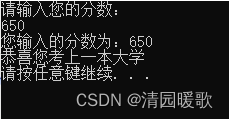
4.1.2 多行 if 语句
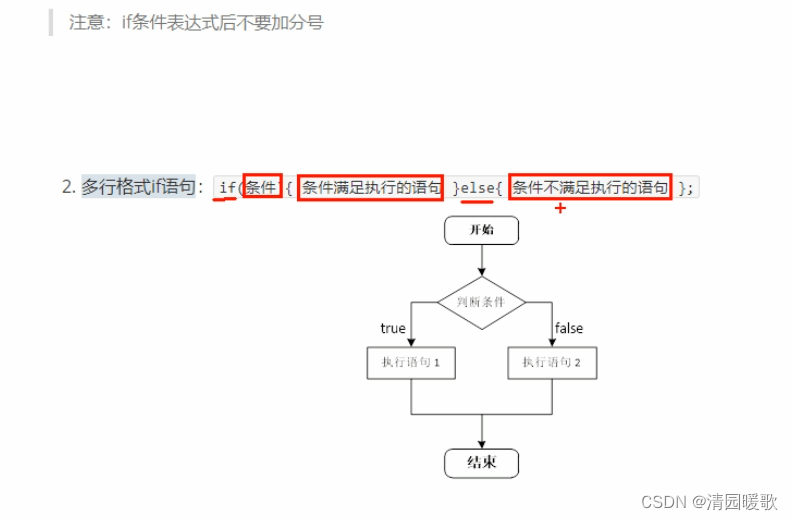
#include<iostream>
using namespace std;
int main()
{
// 选择结构 单行if语句
// 输入分数,大于600,就输出
// 1、用户输入分数
int score = 0;
cout << "请输入您的分数:" << endl;
cin >> score;
// 2、打印用户输入的分数
cout << "您输入的分数为:" << score << endl;
// 3、判断分数是否大于600,大于就输出
// 注意:if后面不要加分号
if (score > 600)
{
cout << "恭喜您考上一本大学" << endl;
}
else
{
cout << "未考上" << endl;
}
system("pause");
return 0;
}4.1.3 多条件 if 语句

#include<iostream>
using namespace std;
int main()
{
// 选择结构 多条件if语句
// 输入分数,大于600,就输出考上,小于就打印未考上
// 1、用户输入分数
int score = 0;
cout << "请输入您的分数:" << endl;
cin >> score;
// 2、打印用户输入的分数
cout << "您输入的分数为:" << score << endl;
// 3、判断分数是否大于600,大于就输出考上,否则未考上
// 注意:if后面不要加分号
if (score > 600)
{
cout << "恭喜您考上一本大学" << endl;
}
else if (score > 500)
{
cout << "恭喜您考上二本大学" << endl;
}
else
{
cout << "抱歉您未考上" << endl;
}
system("pause");
return 0;
}
4.1.4 嵌套 if 语句
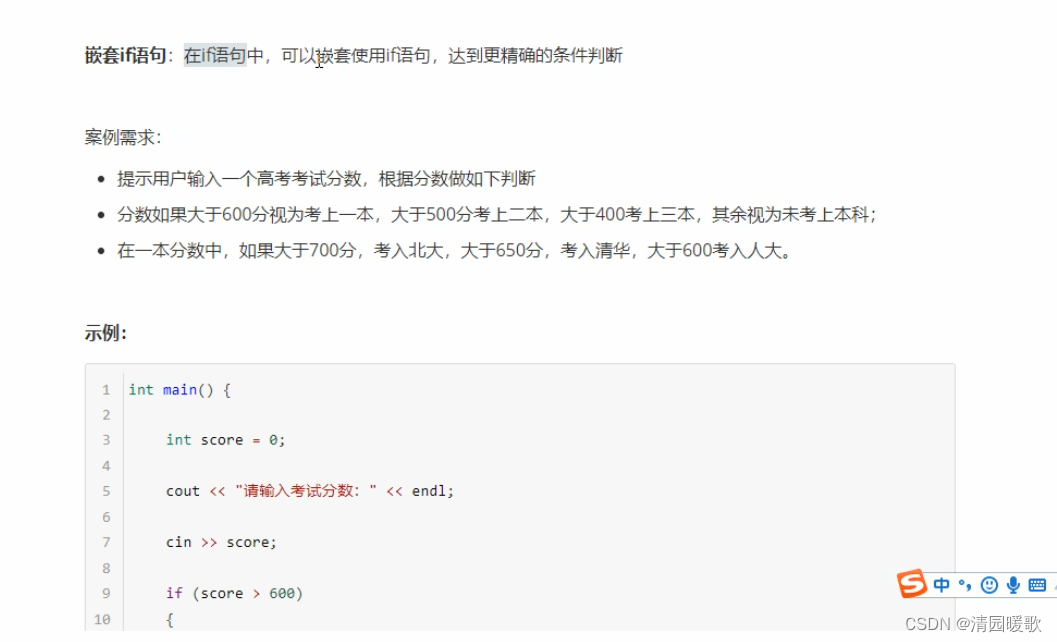
#include<iostream>
using namespace std;
int main()
{
/*
提示用户输入一个高考考试分数,根据分数做如下判断
分数如果大于600分视为考上一本,大于500分考上二本,大于400考上三本,其余视为未考上本科;
在一本分数中,如果大于700分,考入北大,大于650分,考入清华,大于600考入人大。
*/
// 1、提示输入高考分数
int score = 0;
cout << "请输入你的分数:" << endl;
cin >> score;
// 2、显示高考分数
cout << "你的分数是:" << score << endl;
// 3、判断是否大于600,大于就是一本,大于500就是二本
if (score > 600)
{
cout << "恭喜考上一本" << endl;
if (score > 700)
{
cout << "恭喜考上清华" << endl;
}
else if (score > 650)
{
cout << "恭喜考上北大" << endl;
}
else
{
cout << "恭喜考上人大" << endl;
}
}
else if (score > 500)
{
cout << "恭喜考上二本" << endl;
}
else if (score > 400)
{
cout << "恭喜考上三本" << endl;
}
else
{
cout << "未考上" << endl;
}
system("pause");
return 0;
}4.1.5 练习:三只小猪称体重
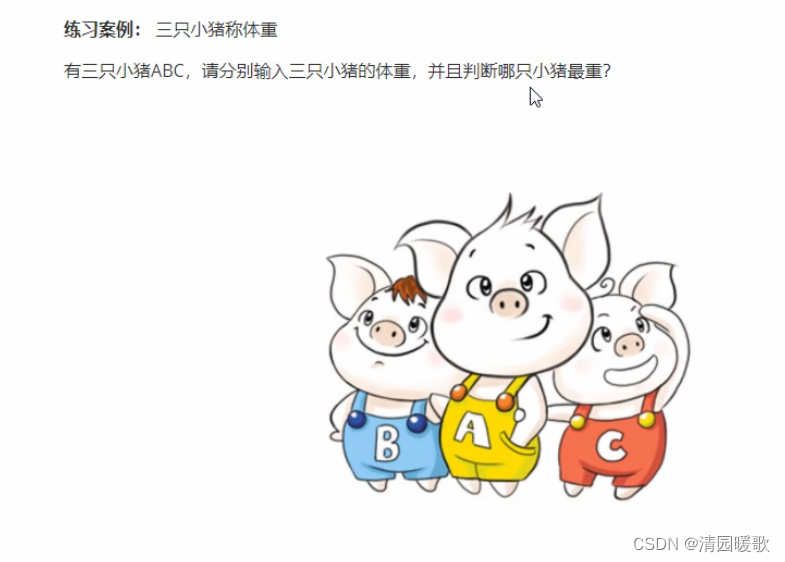

#include<iostream>
using namespace std;
int main()
{
// 三只小猪称体重,判断哪只最重
// 1、创建三只小猪的体重
int num1 = 0;
int num2 = 0;
int num3 = 0;
// 2、让用户输入三只小猪的体重
cout << "请输入小猪A的体重:" << endl;
cin >> num1;
cout << "请输入小猪B的体重:" << endl;
cin >> num2;
cout << "请输入小猪C的体重:" << endl;
cin >> num3;
cout << "小猪A的体重是:" << num1 << endl;
cout << "小猪B的体重是:" << num2 << endl;
cout << "小猪C的体重是:" << num3 << endl;
// 3、判断哪只最重
if (num1 > num2)
{
if (num1 > num3)
{
cout << "小猪A最重" << endl;
}
else
{
cout << "小猪C最重" << endl;
}
}
else
{
if (num2 > num3)
{
cout << "小猪B最重" << endl;
}
else
{
cout << "小猪C最重" << endl;
}
}
system("pause");
return 0;
}4.1.6 三目运算符

#include<iostream>
using namespace std;
int main()
{
// 三目运算符
// 创建三个变量 a,b,c
// 将 a 和 b 做比较,把大的赋给 c
int a = 10;
int b = 20;
int c = 0;
c = (a > b ? a : b);
cout << "c = " << c << endl;
// 在C++中三目运算符返回的变量,可以继续赋值
(a > b ? a : b) = 100;
cout << "a = " << a << endl;
cout << "b = " << b << endl;
system("pause");
return 0;
}
4.1.7 switch 语句

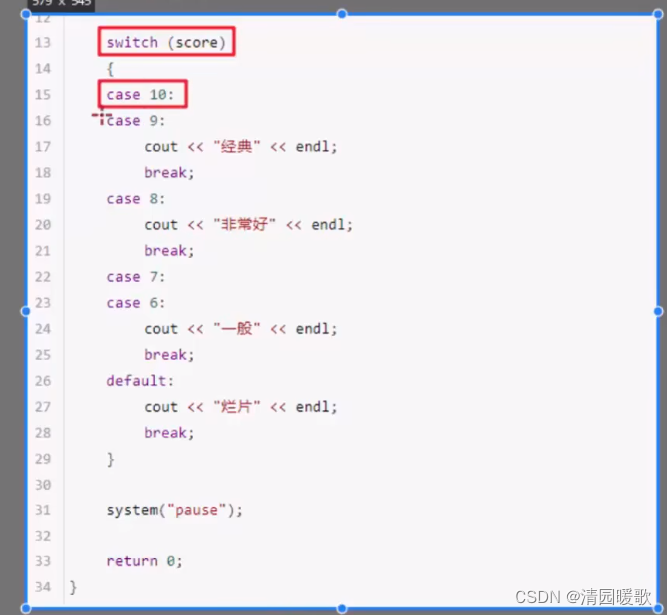
#include<iostream>
using namespace std;
int main()
{
// swutch语句
// 给电影打分
// 10~9 经典
// 8~7 非常好
// 6~5 一般
// 5以下 烂片
// 1、提示用户评分
cout << "请给电影打分:" << endl;
// 2、用户打分
int score = 0;
cin >> score;
cout << "您打的分数是:" << score << endl;
// 3、根据打分提示结果
switch (score)
{
case 10:
cout << "经典" << endl;
break; // 退出,不往下执行
case 9:
cout << "经典" << endl;
break;
case 8:
case 7:
cout << "非常好" << endl;
break;
case 6:
case 5:
cout << "一般" << endl;
break;
default:
cout << "您认为这是一个烂片" << endl;
break;
}
// if 和 switch区别?
// switch 缺点,判断的时候只能是整型huo字符型,不可以是一个区间
// switch 优点,结构清晰,执行效率高
system("pause");
return 0;
}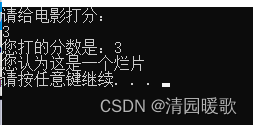
4.2 循环结构
4.2.1 while 循环语句
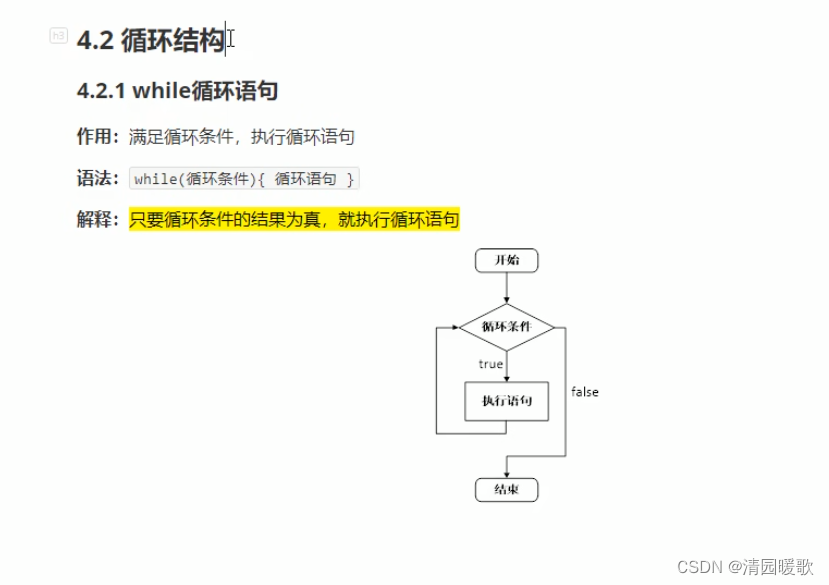
#include<iostream>
using namespace std;
int main()
{
// while 循环
// 在屏幕中打印 0 ~ 9 这十个数字
int num = 0;
// cout << num << endl;
// 注意:循环中要注意出现死循环
while (num < 10)
{
cout << num << endl;
num++;
}
system("pause");
return 0;
}
4.2.2 while 循环练习案例:猜数字


#include<iostream>
using namespace std;
// time系统时间头文件包含
#include<ctime>
int main()
{
// 添加随机数的种子 作用是利用当前系统的时间生成随机数,防止每次随机数都一样
// 不添加的话每次生成的随机数都是一样的
srand((unsigned int)time(NULL));
// 1、系统生成随机数字
int num = rand() % 100 + 1; // 生成 0+1~99+1 的随机数
// cout << "num = " << num << endl;
// 2、猜测
int val = 0;
while (1)
{
cout << "请猜测:" << endl;
cin >> val;
cout << "你输入的数字是:" << val << endl;
// 3、判断
if (val > num)
{
cout << "猜测过大" << endl;
// 猜错 提示重猜
}
else if (val < num)
{
cout << "猜测过小" << endl;
// 猜错 提示重猜
}
else
{
cout << "恭喜猜对了" << endl;
// 猜对 退出
break; // 退出循环
}
}
system("pause");
return 0;
}
4.2.3 do...while 循环语句

#include<iostream>
using namespace std;
// time系统时间头文件包含
#include<ctime>
int main()
{
// do...while语句
// 输出 0~9 十个数字
int num = 0;
do
{
cout << num << endl;
num++;
}
while (num < 10);
/*while (num)
{
cout << num << endl;
num++;
}*/
// do...while和while循环的区别在于 do...while会先执行一次循环语句
system("pause");
return 0;
}
4.2.4 do...while 练习案例:水仙花数
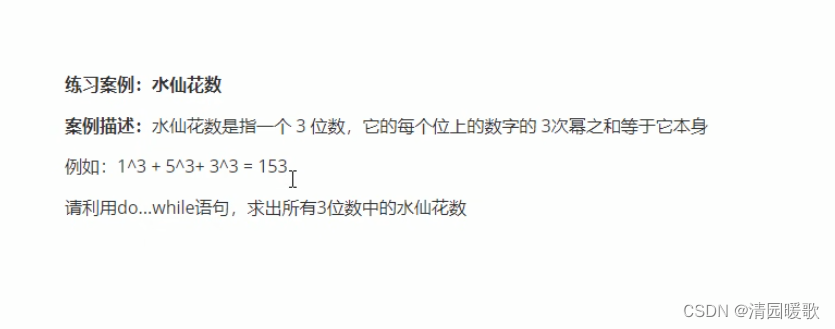

#include<iostream>
using namespace std;
// time系统时间头文件包含
#include<ctime>
int main()
{
// 1、先打印所有三位数字
int num = 100;
do
{
// 2、找到水仙花数打印
int ge = 0;
int shi = 0;
int bai = 0;
ge = num % 10; // 个位
shi = num / 10 % 10; // 十位
bai = num / 100; // 百位
if (ge*ge*ge + shi*shi*shi + bai*bai*bai == num)
{
cout << num << "是水仙花数" << endl;
}
// cout << num << endl;
num++;
} while (num < 1000);
system("pause");
return 0;
}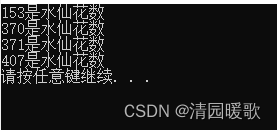
4.2.5 for 循环

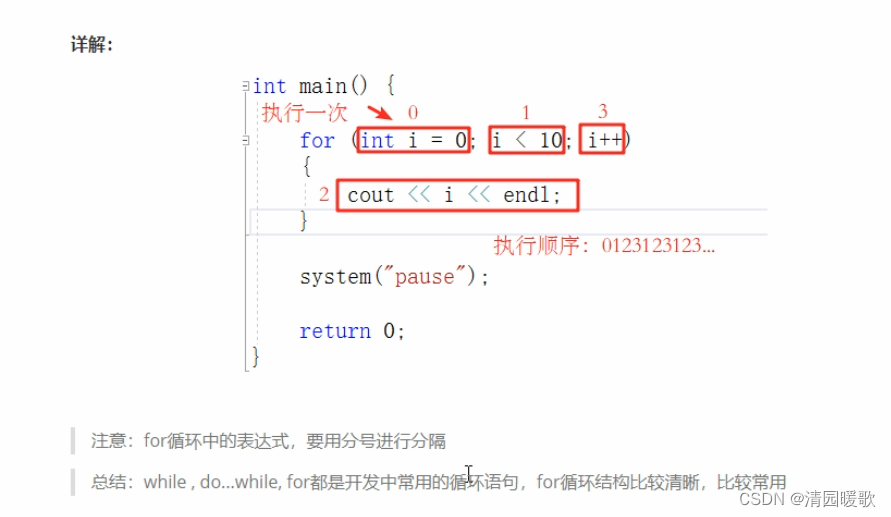
#include<iostream>
using namespace std;
// time系统时间头文件包含
#include<ctime>
int main()
{
// for循环
// 从数字0 打印到 数字9
for (int i = 0; i < 10; i++)
{
cout << i << endl;
}
/*int i = 0;
for (; ; )
{
if (i >= 10)
{
break;
}
cout << i << endl;
i++;
}*/
system("pause");
return 0;
}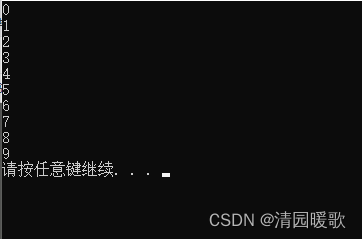
4.2.6 for 练习案例:敲桌子

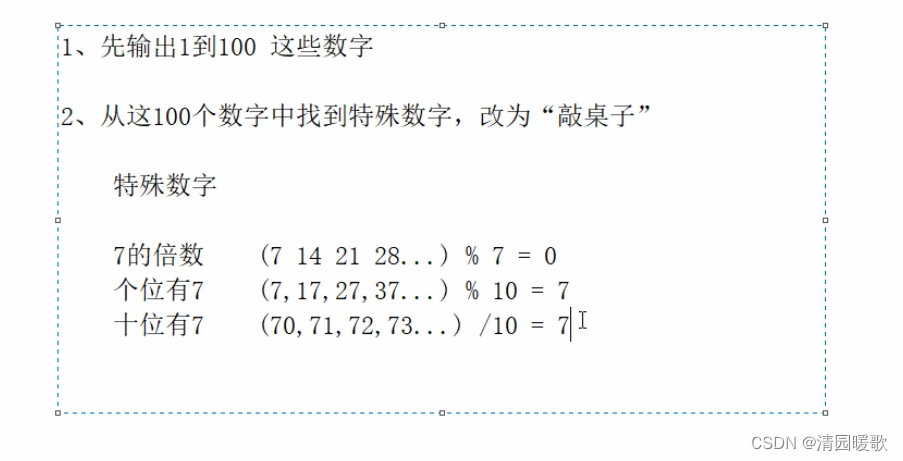
#include<iostream>
using namespace std;
// time系统时间头文件包含
#include<ctime>
int main()
{
// 敲桌子
// 1、先输出100个数字
for (int i = 1; i <= 100; i++)
{
// 2、找到特殊数字并打印
// 7的倍数或个位、十位有7
if (i % 7 == 0 || i % 10 == 7 || i / 10 == 7)
{
cout << "敲桌子" << endl;
}
else
{
cout << i << endl;
}
}
system("pause");
return 0;
}
4.2.7 嵌套循环

#include<iostream>
using namespace std;
// time系统时间头文件包含
#include<ctime>
int main()
{
// 嵌套循环实现*图
// 打印一行星图
/*for (int i = 0; i < 10; i++)
{
cout << "* " ;
}
cout << endl;*/
// 外层执行一次,内层执行一周
// 外层循环
for (int i = 0; i < 10; i++)
{
// 内层循环
for (int j = 0; j < 10; j++)
{
cout << "* ";
}
cout << endl;
}
system("pause");
return 0;
}
4.2.8 嵌套练习案例:乘法口诀表
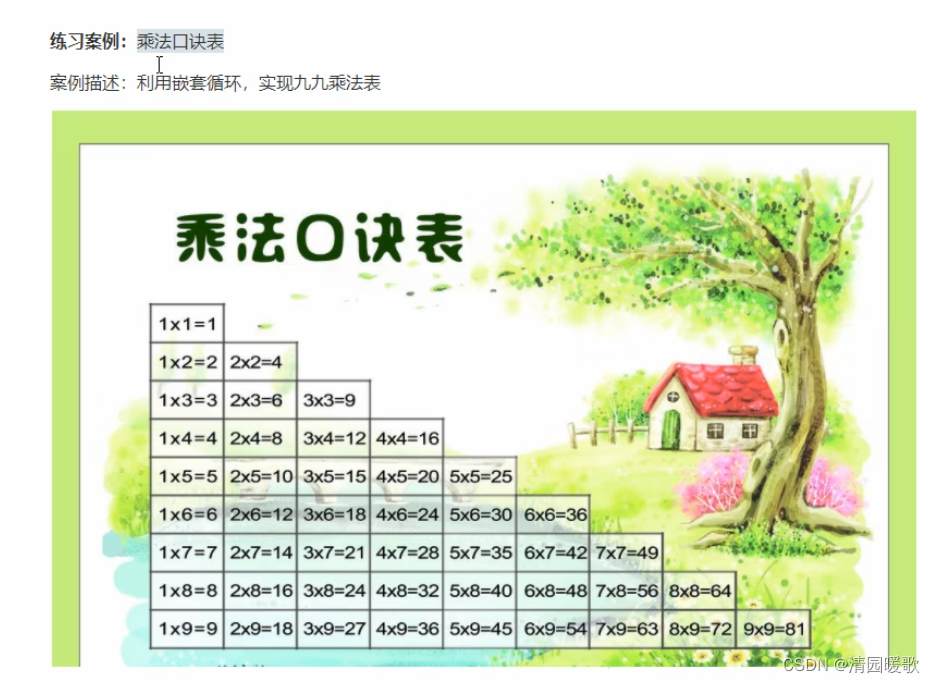
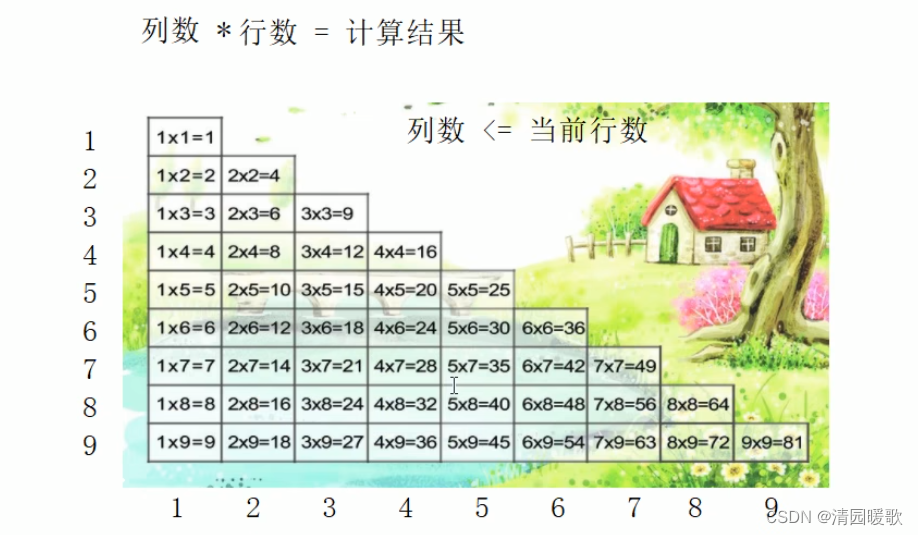
#include<iostream>
using namespace std;
// time系统时间头文件包含
#include<ctime>
int main()
{
//
/*for (int i = 1; i < 10; i++)
{
for (int j = 1; j <= i; j++)
{
cout << " | " << j << " * " << i << " = " << j * i << " | ";
}
cout << endl;
}*/
// 乘法口诀表
for (int i = 1; i <= 9; i++)
{
// cout << i << endl;
for (int j = 1; j <= i; j++)
{
cout << j << "*" << i << "=" << j * i << " ";
}
cout << endl;
}
system("pause");
return 0;
}
4.3 跳转语句
4.3.1 break 语句
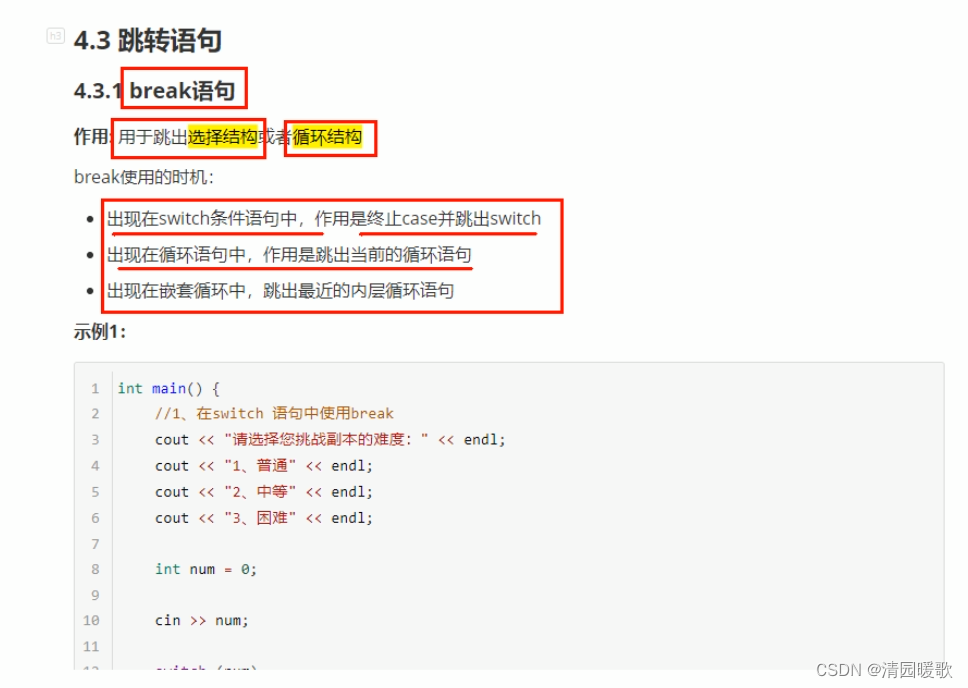
#include<iostream>
using namespace std;
int main()
{
// break的使用时机
// 1、出现在switch语句中
//cout << "请选择副本的难度:" << endl;
//cout << "1、普通" << endl;
//cout << "2、中等" << endl;
//cout << "3、困难" << endl;
//int select = 0; // 创建选择结果的变量
//cin >> select;
//switch (select)
//{
//case 1:
// cout << "您选择的是普通难度" << endl;
// break;
//case 2:
// cout << "您选择的是中等难度" << endl;
// break;
//case 3:
// cout << "您选择的是困难难度" << endl;
// break;
//default:
// cout << "选择错误" << endl;
// break;
//}
// 2、出现在循环语句中
//for (int i = 0; i < 10; i++)
//{
// if (i == 5)
// {
// break; // i=5 就退出循环
// }
// cout << i << endl;
//}
// 3、出现在嵌套循环语句中
for (int i = 0; i < 10; i++)
{
for (int j = 0; j < 10; j++)
{
if (j == 5)
{
break; // 退出内层循环
}
cout << "* ";
}
cout << endl;
}
system("pause");
return 0;
}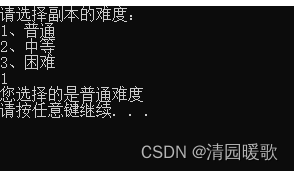


4.3.2 continue 语句

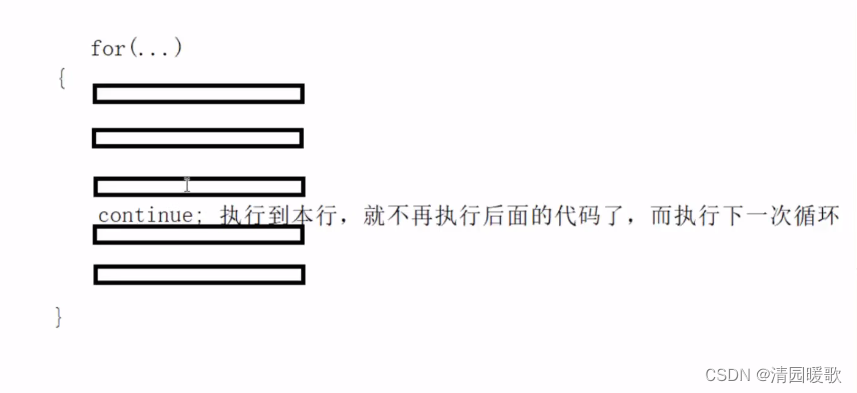
#include<iostream>
using namespace std;
int main()
{
// continue 语句
for (int i = 0; i <= 100; i++)
{
// 奇数就输出,偶数就不输出
if (i % 2 == 0)
{
continue; // 可以筛选条件,执行到此就不再向下执行,执行下一次循环
// break 会退出,continue 不会
}
cout << i << endl;
}
system("pause");
return 0;
}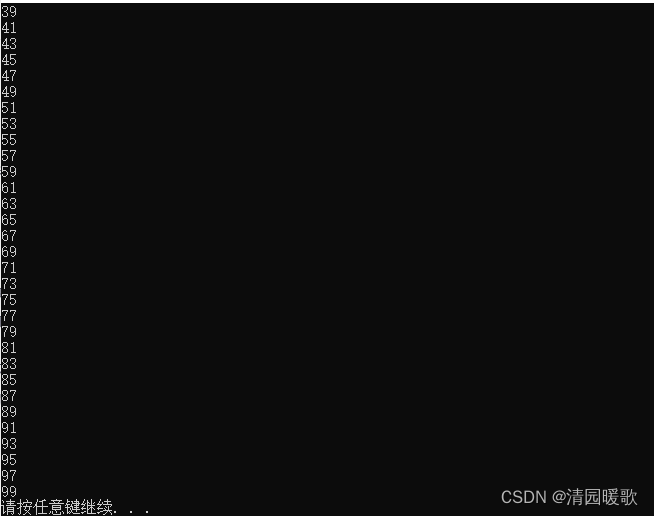
4.3.3 goto 语句


#include<iostream>
using namespace std;
int main()
{
// goto 语句
cout << "1、xxxx" << endl;
cout << "2、xxxx" << endl;
goto FLAG;
cout << "3、xxxx" << endl;
cout << "4、xxxx" << endl;
FLAG:
cout << "5、xxxx" << endl;
system("pause");
return 0;
}
五、数组
5.1 概述
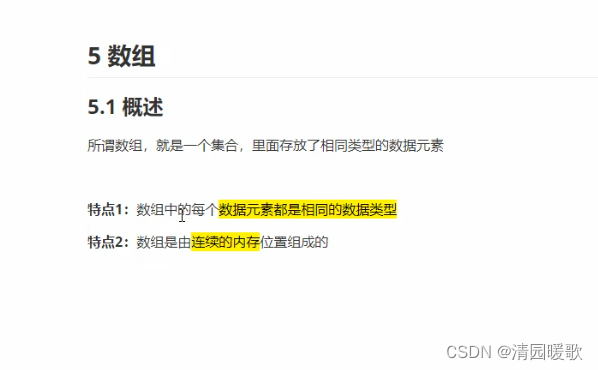

5.2 一维数组
5.2.1 一维数组定义方式
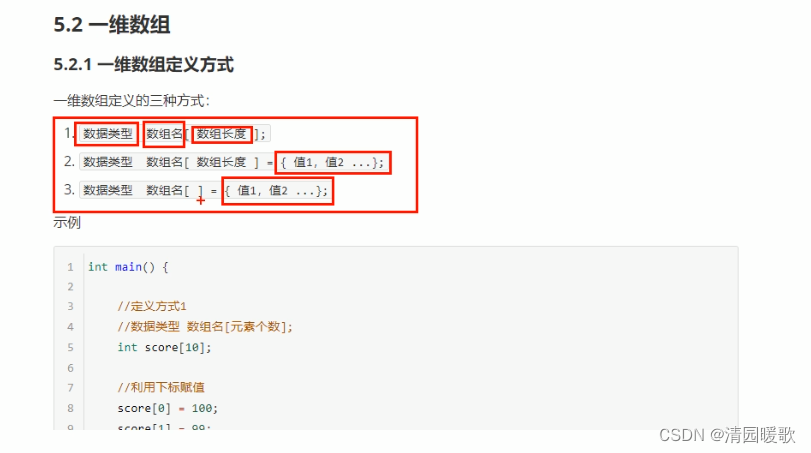
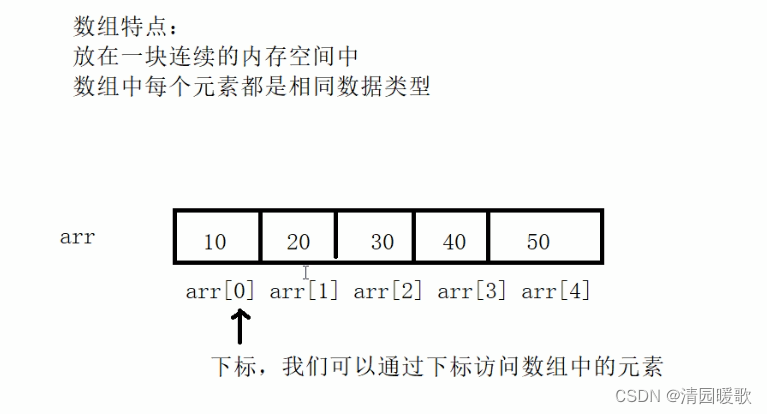

#include<iostream>
using namespace std;
int main()
{
// 数组
// 1.数据类型 数组名[ 数组长度 ];
// 2.数据类型 数组名[ 数组长度 ] = { 值1,值2 ... };
// 3.数据类型 数组名[ ] = { 值1,值2 ... };
// 1、数据类型 数组名[ 数组长度 ];
int arr[5];
// 给数组中的元素进行赋值
// 数组元素的下标是从0开始索引的
arr[0] = 10;
arr[1] = 20;
arr[2] = 30;
arr[3] = 40;
arr[4] = 50;
// 访问数组元素
for (int i = 0; i < 5; i++)
{
cout << arr[i] << endl;
}
// 2、数据类型 数组名[ 数组长度 ] = { 值1,值2 ... };
// 如果初始化数据的时候,没有全部填写完,会用0来填补剩余数据
int arr2[5] = { 100, 200, 300};
for (int i = 0; i < 5; i++)
{
cout << arr2[i] << endl;
}
// 3、数据类型 数组名[ ] = { 值1,值2 ... };
// 定义数组的时候,必须有初始长度
int arr3[] = { 90, 80, 70, 60, 50, 40, 30, 20, 10 };
for (int i = 0; i < 9; i++)
{
cout << arr3[i] << endl;
}
system("pause");
return 0;
}
5.2.2 一维数组数组名

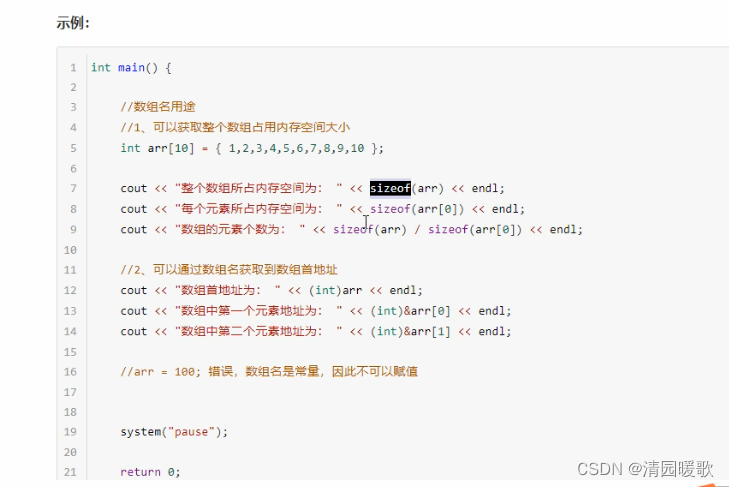

#include<iostream>
using namespace std;
int main()
{
// 数组名用途
// 1、可以通过数组名统计整个数组占用内存大小
int arr[10] = { 1, 2, 3, 4, 5, 6, 7, 8, 9, 10 };
cout << "整个数组占用内存空间为:" << sizeof(arr) << endl;
cout << "sizeof(int) = " << sizeof(int) << endl;
cout << "每个元素占用内存空间为:" << sizeof(arr[0]) << endl;
cout << "数组中元素的个数为:" << sizeof(arr) / sizeof(arr[0]) << endl;
// 2、可以通过数组名查看数组首地址
cout << "数组首地址为(十六进制):" << arr << endl;
cout << "数组首地址为(十进制):" << (int)arr << endl; // 强转成int十进制
cout << "数组中第一个元素的地址为:" << (int)&arr[0] << endl;
cout << "数组中第二个元素的地址为:" << (int)&arr[1] << endl;
// 数组名是常量,不可以进行赋值操作
// arr = 100;是不可以的
system("pause");
return 0;
}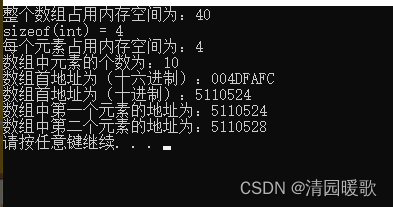
5.2.3 一维数组练习案例1:五只小猪称体重
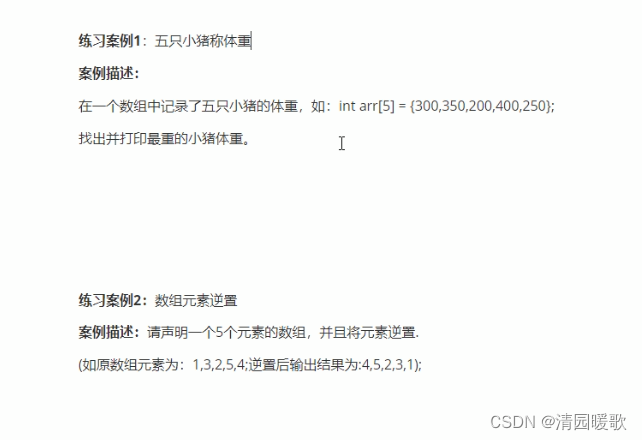

#include<iostream>
using namespace std;
int main()
{
// 1、创建5只小猪体重的数组
int arr[5] = { 300, 350, 200, 400, 250 };
// 2、从数组中找到最大值
int max = 0;
for (int i = 0; i < 5; i++)
{
// cout << arr[i] << endl;
if (arr[i] > max)
{
max = arr[i];
}
}
// 3、打印最大值
cout << "最重的小猪体重为:" << max << endl;
system("pause");
return 0;
}
5.2.4 一维数组练习案例2:数组元素逆置


#include<iostream>
using namespace std;
int main()
{
// 实现数组元素逆置
// 1、创建数组
int arr[5] = { 1, 3, 2, 5, 4 };
cout << "数组逆置前:" << endl;
for (int i = 0; i < 5; i++)
{
cout << arr[i] << endl;
}
// 2、实现逆置
// 2.1 记录起始下标位置
// 2.2 记录结束下标位置
// 2.3 起始下标与结束下标的元素互换
// 2.4 起始位置++, 结束位置--
// 2.5 循环执行2.1操作,直到起始位置 >= 结束位置
int start = 0; // 起始下标
int end = sizeof(arr) / sizeof(arr[0]) - 1; // 结束下标
while (start <= end)
{
// 实现元素互换
int temp = arr[start];
arr[start] = arr[end];
arr[end] = temp;
// 下标更新
start++;
end--;
}
// 3、打印逆置后的数组
cout << "数组逆置后:" << endl;
for (int i = 0; i < 5; i++)
{
cout << arr[i] << endl;
}
system("pause");
return 0;
}
5.2.5 冒泡排序
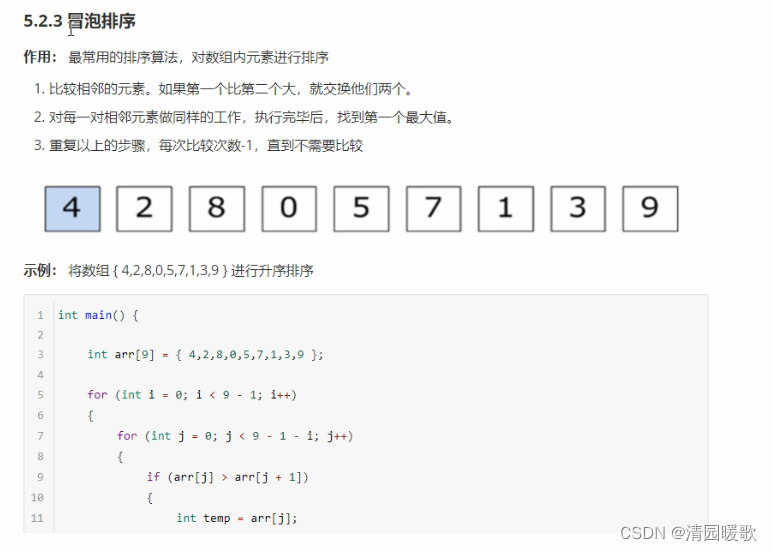

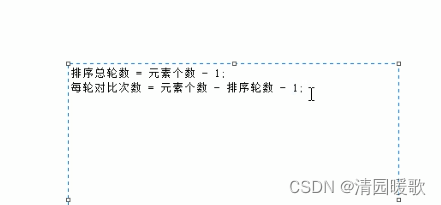
#include<iostream>
using namespace std;
int main()
{
// 利用冒泡排序实现升序序列
int arr[9] = { 4, 2, 8, 0, 5, 7, 1, 3, 9 };
cout << "排序前:" << endl;
for (int i = 0; i < 9; i++)
{
cout << arr[i] << " ";
}
cout << endl;
// 开始冒泡排序
// 总共排序的轮数为 元素个数 - 1
for (int i = 0; i < 9 - 1; i++)
{
// 内层循环对比 次数 = 元素个数 - 当前轮数 - 1
for (int j = 0; j < 9 - i - 1; j++)
{
// 如果第一个数字,比第二个数字大,交换两个数字
if (arr[j] > arr[j + 1])
{
int temp = arr[j];
arr[j] = arr[j + 1];
arr[j + 1] = temp;
}
}
}
// 排序后结果
cout << "排序后:" << endl;
for (int i = 0; i < 9; i++)
{
cout << arr[i] << " ";
}
cout << endl;
system("pause");
return 0;
}
5.3 二维数组
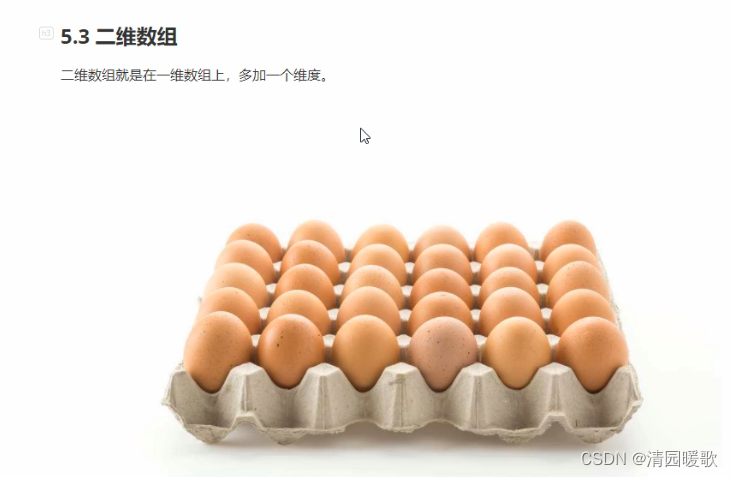
5.3.1 二维数组定义方式
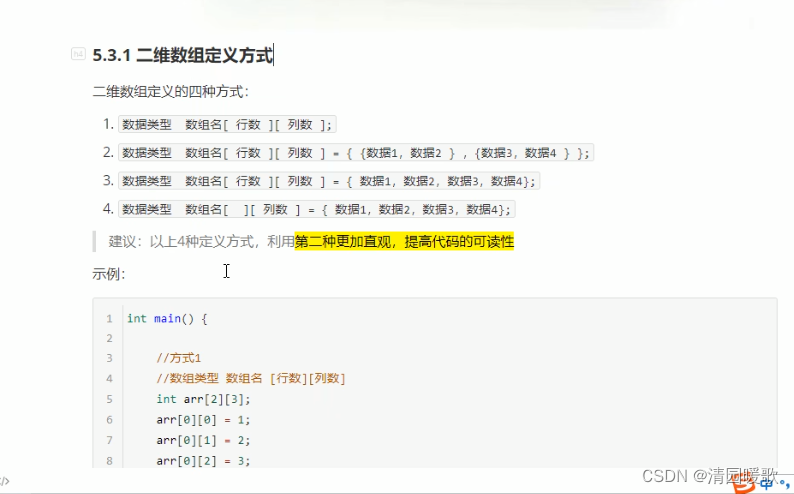

arr[2][3]
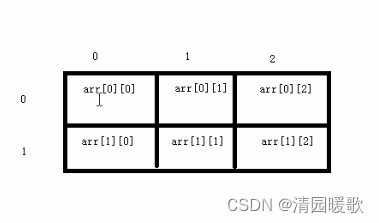
#include<iostream>
using namespace std;
int main()
{
// 二维数组定义方式
/*
1. 数据类型数组名[行数][列数];
2.数据类型数组名[行数][列数] = { {数据1,数据2},{数据3,数据4 } };
3.数据类型数组名[行数][列数] = { 数据1,数据2,数据3,数据4 };
4.数据类型数组名[][列数] = { 数据1,数据2,数据3,数据4 };
*/
// 1、数据类型数组名[行数][列数];
int arr[2][3];
arr[0][0] = 1;
arr[0][1] = 2;
arr[0][2] = 3;
arr[1][0] = 4;
arr[1][1] = 5;
arr[1][2] = 6;
for (int i = 0; i < 2; i++)
{
for (int j = 0; j < 3; j++)
{
cout << arr[i][j] << endl;
}
}
// 2、数据类型数组名[行数][列数] = { {数据1,数据2},{数据3,数据4 } };
int arr2[2][3] =
{
{1, 2, 3},
{4, 5, 6}
};
for (int i = 0; i < 2; i++)
{
for (int j = 0; j < 3; j++)
{
cout << arr2[i][j] << " ";
}
cout << endl;
}
// 3、数据类型数组名[行数][列数] = { 数据1,数据2,数据3,数据4 };
int arr3[2][3] = { 1, 2, 3, 4, 5, 6 };
for (int i = 0; i < 2; i++)
{
for (int j = 0; j < 3; j++)
{
cout << arr3[i][j] << " ";
}
cout << endl;
}
// 4、数据类型数组名[][列数] = { 数据1,数据2,数据3,数据4 };
int arr4[][3] = { 1, 2, 3, 4, 5, 6 };
for (int i = 0; i < 2; i++)
{
for (int j = 0; j < 3; j++)
{
cout << arr4[i][j] << " ";
}
cout << endl;
}
system("pause");
return 0;
}
5.3.2 二维数组数组名
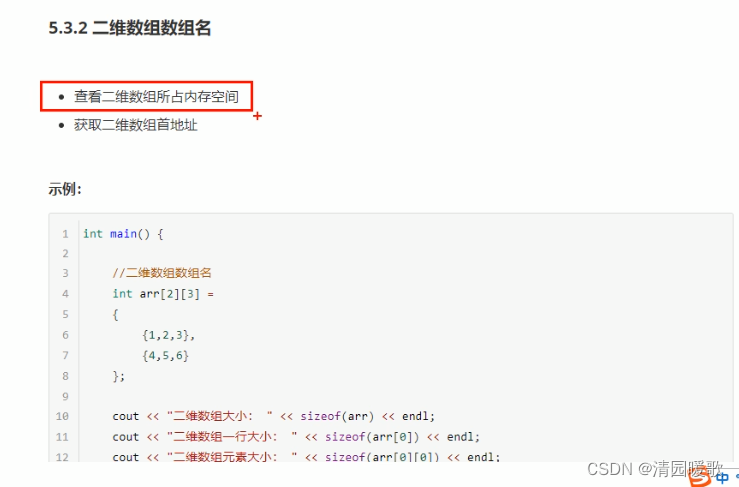
#include<iostream>
using namespace std;
int main()
{
// 二维数组名称用途
// 1、可以查看占用内存大小
int arr[2][3] =
{
{1, 2, 3},
{4, 5, 6}
};
cout << "二维数组(int)占用内存大小为:" << sizeof(arr) << endl;
double arr2[2][3] =
{
{1, 2, 3},
{4, 5, 6}
};
cout << "二维数组(double)占用内存大小为:" << sizeof(arr2) << endl;
cout << "二维数组第一行占用内存为:" << sizeof(arr[0]) << endl;
cout << "二维数组第一个元素占用内存为:" << sizeof(arr[0][0]) << endl;
cout << "二维数组的行数为:" << sizeof(arr) / sizeof(arr[0]) << endl;
cout << "二维数组的列数为:" << sizeof(arr[0]) / sizeof(arr[0][0]) << endl;
// 2、可以查看二维数组的首地址
cout << "二维数组的首地址为:" << arr << endl;
cout << "二维数组的首地址为:" << (int)arr << endl;
cout << "二维数组中第一行首地址为:" << (int)arr[0] << endl;
cout << "二维数组中第二行首地址为:" << (int)arr[1] << endl;
cout << "二维数组中第一个元素首地址为:" << (int)&arr[0][0] << endl;
cout << "二维数组中第二个元素首地址为:" << (int)&arr[0][1] << endl;
system("pause");
return 0;
}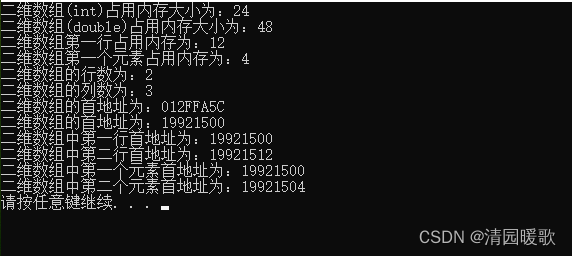
5.3.3 二维数组应用案例:考试成绩统计


#include<iostream>
using namespace std;
#include<string>
int main()
{
// 二维数组案例-考试成绩统计
// 1、创建二维数组
int scores[3][3] =
{
{100, 100, 100},
{90, 50, 100},
{60, 70, 80}
};
string name[3] = { "张三", "李四", "王五" };
// 2、统计每个人的总和分数
for (int i = 0; i < 3; i++)
{
int sum = 0;
for (int j = 0; j < 3; j++)
{
sum += scores[i][j];
cout << scores[i][j] << " ";
}
cout << name[i] << "的总分为:" << sum << endl;
}
system("pause");
return 0;
}
六、函数
6.1 概述

6.2 函数的定义


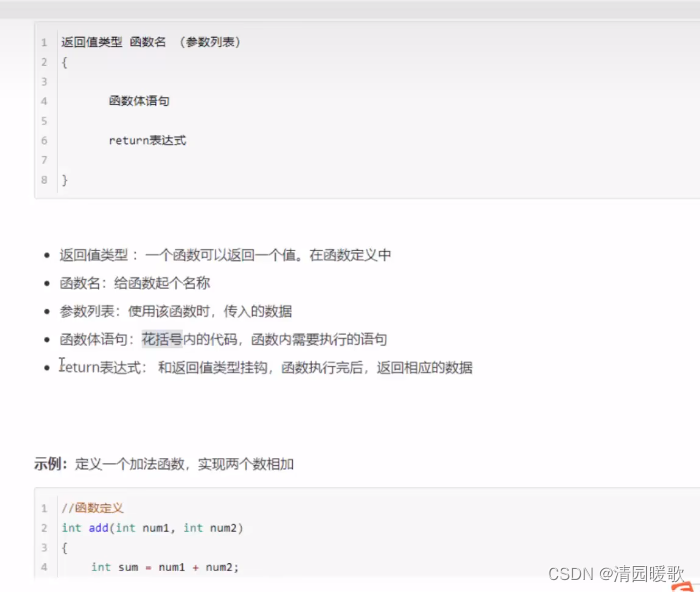
#include<iostream>
using namespace std;
// 函数的定义
// 语法:
// 返回值类型 函数名 (参数列表) {函数体语句 return表达式}
// 加法函数实现
int add(int num1, int num2)
{
int sum = num1 + num2;
return sum;
}
int main()
{
system("pause");
return 0;
}6.3 函数的调用
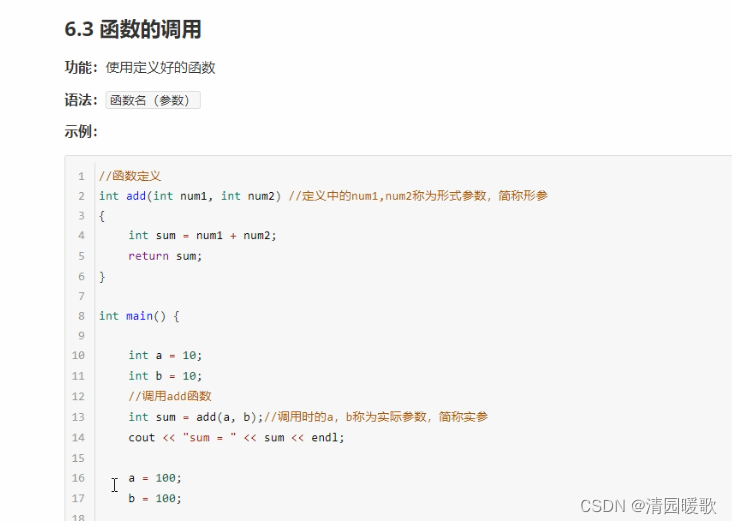

#include<iostream>
using namespace std;
// 函数的定义
// 语法:
// 返回值类型 函数名 (参数列表) {函数体语句 return表达式}
// 加法函数实现
// 函数定义时,num1和num2没有实际数据
// 只是一个形式上的参数,简称形参
int add(int num1, int num2)
{
int sum = num1 + num2;
return sum;
}
int main()
{
int a = 10;
int b = 20;
// 函数调用
// a和b称为 实际参数,简称实参
// 调用时,实参的值会传递给形参
int c = add(a, b);
cout << "c = " << c << endl;
a = 100;
b = 500;
c = add(a, b);
cout << "c = " << c << endl;
system("pause");
return 0;
}
6.4 值传递

值传递时,形参发生改变,不会影响实参
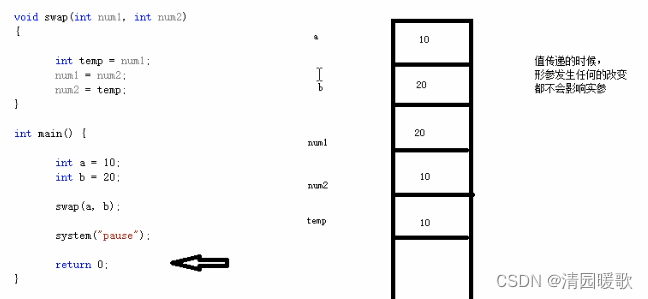
#include<iostream>
using namespace std;
// 值传递
// 定义函数,实现两个数字进行交换函数
// 如果函数不需要返回值,声明的时候可以写 void
void swap(int num1, int num2)
{
cout << "交换前:" << endl;
cout << "num1 = " << num1 << endl;
cout << "num2 = " << num2 << endl;
int temp = num1;
num1 = num2;
num2 = temp;
cout << "交换后:" << endl;
cout << "num1 = " << num1 << endl;
cout << "num2 = " << num2 << endl;
// return; 返回值不需要的时候,可以不写return
}
int main()
{
int a = 10;
int b = 20;
cout << "a = " << a << endl;
cout << "b = " << b << endl;
// 当我们做值传递的时候,函数的形参发生改变,并不会影响实参
swap(a, b);
cout << "a = " << a << endl;
cout << "b = " << b << endl;
system("pause");
return 0;
}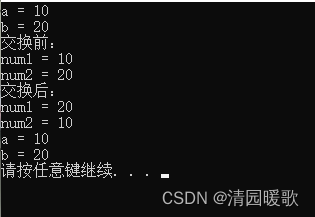
6.5 函数的常见样式
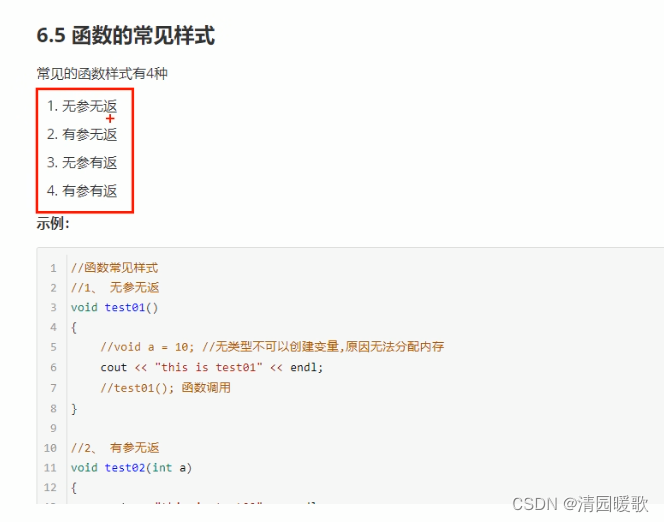
#include<iostream>
using namespace std;
// 函数的常见样式
// 1、无参无返
void test01()
{
cout << "this is test01" << endl;
}
// 2、有参无返
void test02(int a)
{
cout << "this is test02 a = " << a << endl;
}
// 3、无参有返
int test03()
{
cout << "this is test03" << endl;
return 1000;
}
// 4、有参有返
int test04(int a)
{
cout << "this is test04 a = " << a << endl;
return a;
}
int main()
{
// 1、无参无返
test01();
// 2、有参无返
test02(100);
// 3、无参有返
int num1 = test03();
cout << "num1 = " << num1 << endl;
// 4、有参有返
int num2 = test04(456);
cout << "num2 = " << num2 << endl;
system("pause");
return 0;
}
6.6 函数的声明

#include<iostream>
using namespace std;
// 函数的声明
// 比较函数,实现两个整型数字进行比较,返回较大的值
// 定义,max函数必须卸载main的前面
// 所以可以提前告诉编译器函数的存在,可以利用函数的声明
// 声明可以写多次,但是定义只能有一次
int max(int a, int b);
int max(int a, int b);
int max(int a, int b);
int main()
{
int a = 10;
int b = 20;
cout << max(a, b) << endl;
system("pause");
return 0;
}
int max(int a, int b)
{
return a > b ? a : b;
}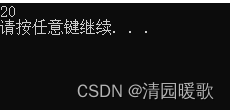
6.7 函数的分文件编写
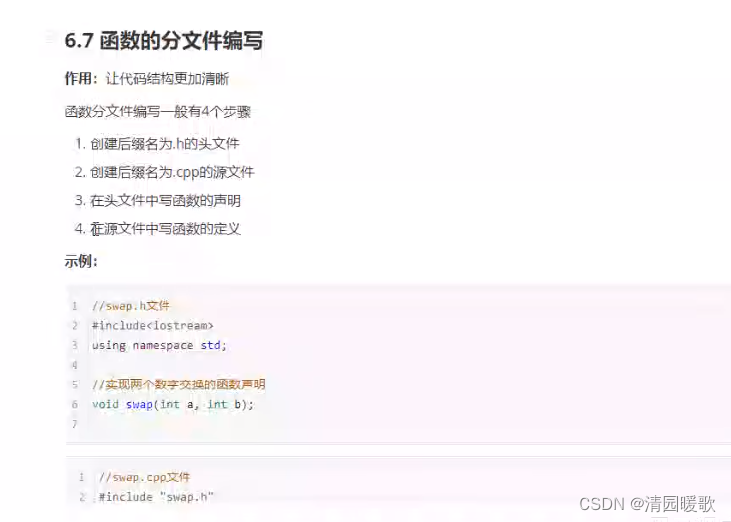
#include<iostream>
using namespace std;
#include "swap.h" // 双引号表示自定义的头文件
// 函数的分文件编写
// 实现两个数字进行交换的函数
函数的声明
//void swap(int a, int b);
函数的定义
//void swap(int a, int b)
//{
// int temp = a;
// a = b;
// b = temp;
// cout << "a = " << a << endl;
// cout << "b = " << b << endl;
//}
// 1、创建.h后缀名的头文件
// 2、创建.cpp后缀名的源文件
// 3、在头文件写函数的声明
// 4、在源文件中先函数的定义
int main()
{
int a = 10;
int b = 20;
swap(a, b);
system("pause");
return 0;
}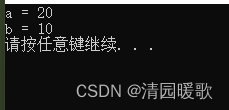
swap.h
#include<iostream>
using namespace std;
// 函数的声明
void swap(int a, int b);
swap.c
#include "swap.h" // 双引号表示自定义的头文件
// 函数的定义
void swap(int a, int b)
{
int temp = a;
a = b;
b = temp;
cout << "a = " << a << endl;
cout << "b = " << b << endl;
}七、指针
7.1 指针的基本概念

7.2 指针变量的定义和使用

#include<iostream>
using namespace std;
#include<string>
int main()
{
// 1、定义指针
int a = 10;
// 指针定义的语法:数据类型 * 指针变量名;
int * p;
// 让指针记录变量a的地址
p = &a;
cout << "a的地址为: " << &a << endl;
cout << "a的地址为: " << (int)&a << endl;
cout << "指针p为: " << p << endl;
// 2、使用指针
// 可以通过解引用的方式来找到指针指向的内存
// 指针前加 * 代表解引用,找到指针指向的内存中的数据
*p = 1000;
cout << "a = " << a << endl;
cout << "*p = " << *p << endl;
system("pause");
return 0;
}
7.3 指针所占内存空间
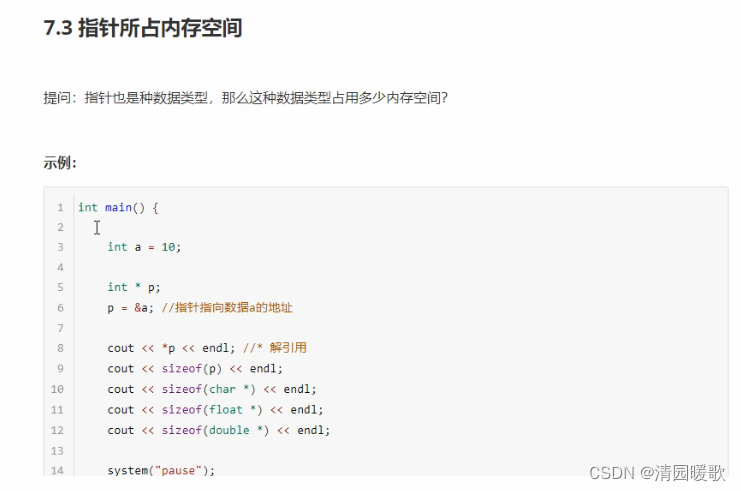
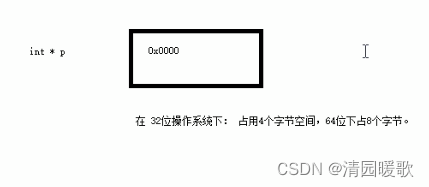
#include<iostream>
using namespace std;
#include<string>
int main()
{
// 指针所占内存空间
int a = 10;
// int * p;
// p = &a;
int * p = &a;
// 32位操作系统下,指针是占4个字节空间大小,不管什么数据类型
// 32位操作系统下,指针是占8个字节空间大小,不管什么数据类型
cout << "sizeof(int *) = " << sizeof(int *) << endl;
cout << "sizeof(float *) = " << sizeof(float *) << endl;
cout << "sizeof(double *) = " << sizeof(double *) << endl;
cout << "sizeof(char *) = " << sizeof(char *) << endl;
cout << "sizeof(p) = " << sizeof(p) << endl;
system("pause");
return 0;
}
7.4 空指针和野指针
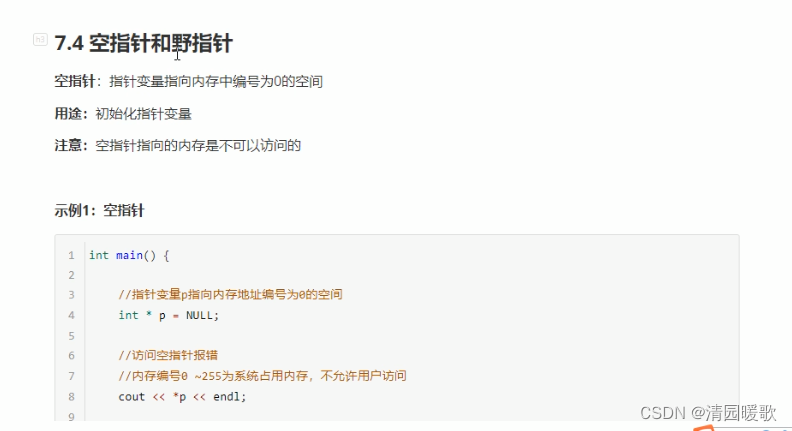
#include<iostream>
using namespace std;
#include<string>
int main()
{
// 空指针
// 1、空指针用于给指针变量进行初始化
int* p = NULL;
// 2、空指针是不可以进行访问的
// 0 ~ 255 之间的内存编号是系统占用的,因此不可以访问
// *p = 100; 会报错
system("pause");
return 0;
}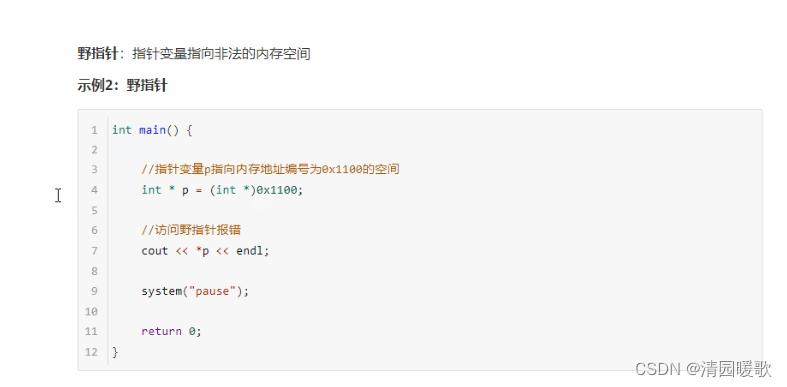
#include<iostream>
using namespace std;
#include<string>
int main()
{
// 野指针
// 在程序中,尽量避免出现野指针
int* p = (int *)0x1100;
// cout << *p << endl; 会报错
system("pause");
return 0;
}7.5 const修饰指针

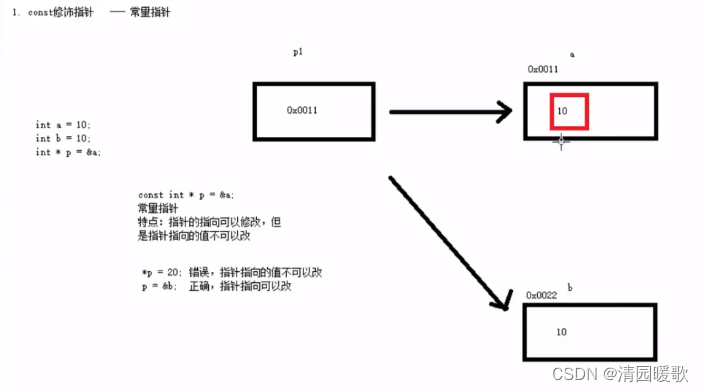
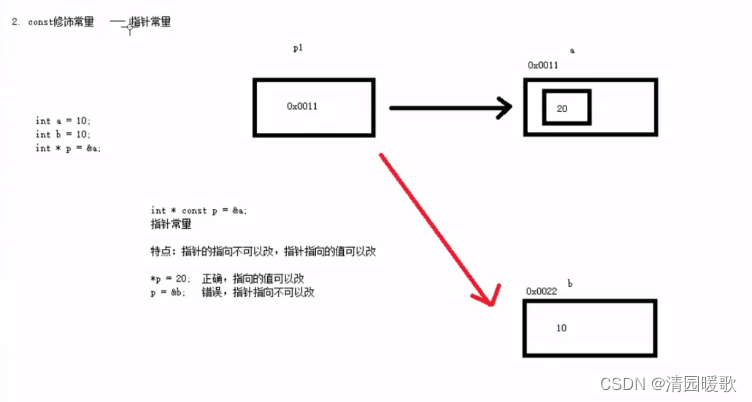

#include<iostream>
using namespace std;
#include<string>
int main()
{
// 1、const修饰指针(常量指针)
int a = 10;
int b = 20;
const int * p = &a;
// 指针指向的值不可以改,指针的指向可以改
// *p = 20; 错误
p = &b; // 正确
// 2、const修饰常量(指针常量)
// 指针的指向不可以改,指针指向的值可以改
int* const p2 = &a;
*p2 = 100; // 正确
// p2 = &b; 错误,指针的指向不可以改
// 3、const修饰指针和常量(既修饰指针也修饰常量)
const int* const p3 = &a;
// 指针的指向 和 指针指向的值 都不可以改
// *p3 = 100; 错误
// p3 = &b; 错误
system("pause");
return 0;
}7.6 指针和数组
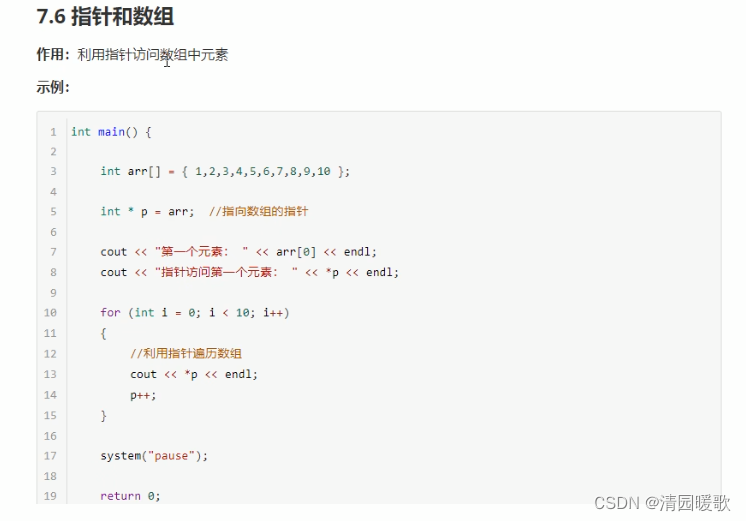
#include<iostream>
using namespace std;
#include<string>
int main()
{
// 指针和数组
// 利用指针访问数组中的元素
int arr[10] = { 1, 2, 6, 4, 5, 6, 7, 8, 9, 10 };
cout << "第一个元素为:" << arr[0] << endl;
int* p = arr; // arr就是数组首地址
cout << "利用指针访问第一个元素:" << *p << endl;
p++; // 让指针向后偏移4个字节
cout << "利用指针访问第二个元素:" << *p << endl;
cout << "利用指针访问第三个元素:" << *(p+1) << endl;
cout << "利用指针遍历数组 " << endl;
int* p2 = arr;
for (int i = 0; i < 10; i++)
{
// cout << arr[i] << endl;
cout << *p2 << endl;
p2++;
}
system("pause");
return 0;
}
7.7 指针和函数

#include<iostream>
using namespace std;
#include<string>
// 实现两个数字交换
void swap01(int a, int b)
{
int temp = a;
a = b;
b = temp;
}
void swap02(int* p1, int* p2)
{
int temp = *p1;
*p1 = *p2;
*p2 = temp;
}
int main()
{
// 指针和函数
// 1、值传递
int a = 10;
int b = 20;
swap01(a, b);
cout << "a = " << a << endl;
cout << "b = " << b << endl;
// 2、地址传递
// 如果是地址传递,可以修饰实参
swap02(&a, &b);
cout << "a = " << a << endl;
cout << "b = " << b << endl;
system("pause");
return 0;
}

7.8 指针、数组、函数

#include<iostream>
using namespace std;
#include<string>
// 冒泡排序函数
void bubbleSort(int * arr, int len)
{
for (int i = 0; i < len - 1; i++)
{
for (int j = 0; j < len - i - 1; j++)
{
// 如果 j > j+1 的值,就交换数字
if (arr[j] > arr[j + 1])
{
int temp = arr[j];
arr[j] = arr[j + 1];
arr[j + 1] = temp;
}
}
}
}
// 打印数组
void printArray(int* arr, int len)
{
for (int i = 0; i < len; i++)
{
cout << arr[i] << endl;
}
}
int main()
{
// 1、先创建数组
int arr[10] = { 4, 3, 6, 9, 1, 2, 10, 8, 7, 5 };
// 数组长度
int len = sizeof(arr) / sizeof(arr[0]);
// 2、创建函数,实现冒泡排序
bubbleSort(arr, len);
// 3、 打印排序后的数组
printArray(arr, len);
system("pause");
return 0;
}
八、结构体
8.1 结构体基本概念

8.2 结构体定义和使用

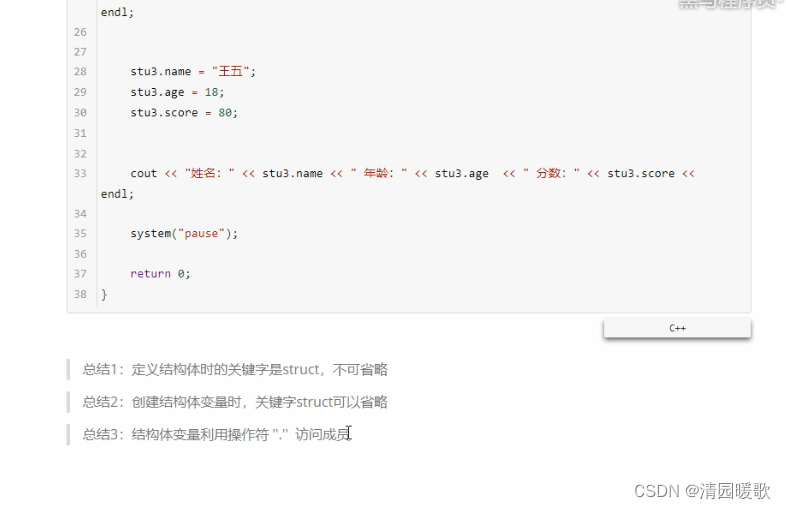
#include<iostream>
using namespace std;
#include<string>
// 1、创建学生数据类型 :学生包括(姓名, 年龄, 分数)
// 自定义数据类型,一些类型集合组成的一个类型
// 语法 struct类型名称 { 成员列表 }
struct Student
{
// 成员列表
// 姓名
string name;
// 年龄
int age;
// 分数
int score;
};
// 2、通过学生类型创建具体学生
int main()
{
// 2.1 struct Student s1
// struct 关键字可以省略
struct Student s1;
// Student s1;
// 给s1属性赋值,通过.访问结构体变量中的属性
s1.name = "张三";
s1.age = 18;
s1.score = 100;
cout << "姓名: " << s1.name << " 年龄: " << s1.age << " 分数: " << s1.score << endl;
// 2.2 struct Student s2 = { ... }
struct Student s2 = {"李四", 19, 80};
cout << "姓名: " << s2.name << " 年龄: " << s2.age << " 分数: " << s2.score << endl;
// 2,3 在定义结构体时顺便创建结构体变量
//struct Student
//{
// // 成员列表
// // 姓名
// string name;
// // 年龄
// int age;
// // 分数
// int score;
//}s3; // 顺便创建结构体变量
/*s3.name = "王五";
s3.age = 20;
s3.score = 60;
cout << "姓名: " << s3.name << "年龄: " << s3.age << "分数: " << s3.score << endl;*/
system("pause");
return 0;
}
8.3 结构体数组
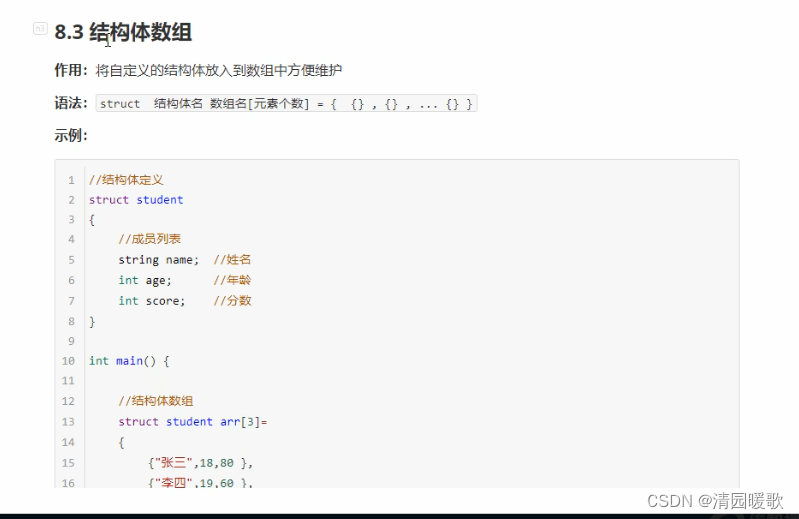
#include<iostream>
using namespace std;
#include<string>
// 结构体数组
// 1、定义结构体
struct Student
{
// 姓名
string name;
// 年龄
int age;
// 分数
int score;
};
int main()
{
// 2、创建结构体数组
struct Student stuArray[3] =
{
{"张三", 18, 100},
{"李四", 28, 99},
{"王五", 38, 66}
};
// 3、给结构体数组中的元素赋值
stuArray[2].name = "赵六";
stuArray[2].age = 80;
stuArray[2].score = 60;
// 4、遍历结构体数组
for (int i = 0; i < 3; i++)
{
cout << "姓名: " << stuArray[i].name
<< "年龄: " << stuArray[i].age
<< "分数: " << stuArray[i].score << endl;
}
system("pause");
return 0;
}
8.4 结构体指针
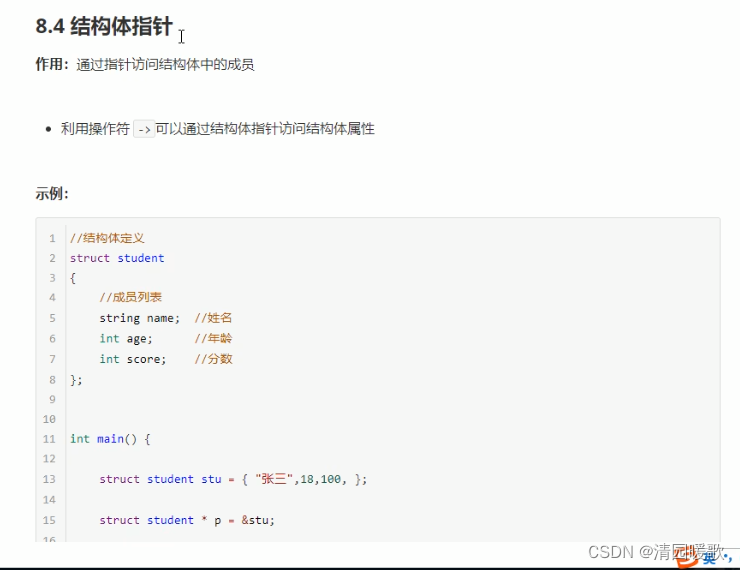
#include<iostream>
using namespace std;
#include<string>
// 结构体指针
struct student
{
// 姓名
string name;
// 年龄
int age;
// 分数
int score;
};
int main()
{
// 1、创建学生的结构体变量
struct student s = { "张三", 18, 100 };
// 2、通过指针指向结构体变量
struct student * p = &s; // struct可以省略
// 3、通过指针访问结构体变量中的数据
// 通过结构体指针 访问结构体中的属性,需要利用 '->'
cout << "姓名: " << p->name << " 年龄: " << p->age << " 分数: " << p->score << endl;
system("pause");
return 0;
}
8.5 结构体嵌套结构体
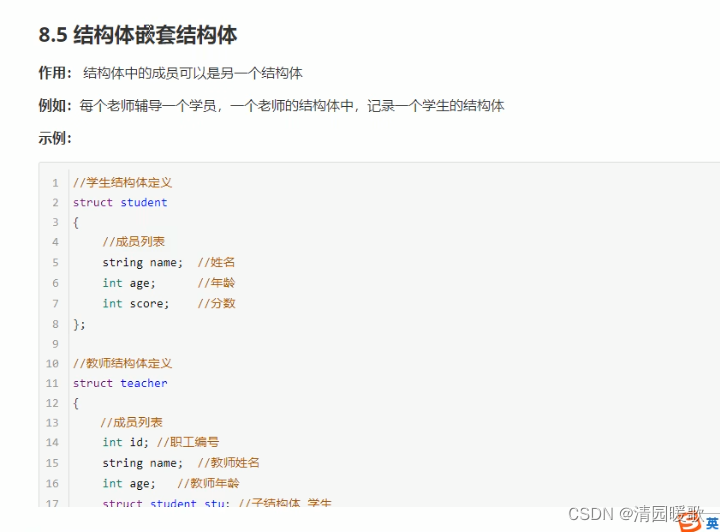

#include<iostream>
using namespace std;
#include<string>
// 定义学生的结构体
struct student
{
string name;
int age;
int score;
};
// 定义老师结构体
struct teacher
{
int id; // 编号
string name; // 姓名
int age; // 年龄
struct student stu; // 学生的结构体
};
int main()
{
// 结构体嵌套结构体
// 创建老师
teacher t;
t.id = 10000;
t.name = "老王";
t.age = 50;
t.stu.name = "小王";
t.stu.age = 20;
t.stu.score = 60;
cout << "老师姓名: " << t.name << " 老师编号: " << t.id << " 老师年龄: " << t.age
<< " 老师辅导的学生姓名: " << t.stu.name << " 学生年龄: "<< t.stu.age
<< " 学生考试分数为: " << t.stu.score << endl;
system("pause");
return 0;
}
8.6 结构体做函数参数
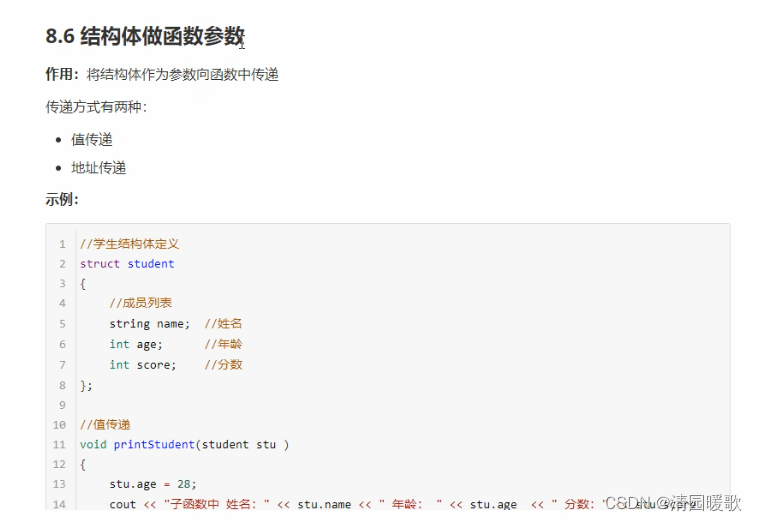

#include<iostream>
using namespace std;
#include<string>
// 定义学生的结构体
struct student
{
string name;
int age;
int score;
};
// 打印学生信息的函数
// 1、值传递
void printStudent1(struct student s)
{
// 修改 s.age = 100; 不会改变实参
s.age = 100;
cout << "子函数1中 姓名: " << s.name << " 年龄: " << s.age << " 分数: " << s.score << endl;
}
// 2、地址传递
void printStudent2(struct student * p)
{
// 修改 s.age = 100; 会改变实参
p->age = 200;
cout << "子函数2中 姓名: " << p->name << " 年龄: " << p->age << " 分数: " << p->score << endl;
}
int main()
{
// 结构体做函数参数
// 将学生传入到一个参数中,打印学生身上的所有信息
// 创建结构体变量
struct student s;
s.name = "张三";
s.age = 20;
s.score = 85;
cout << "main函数中初始打印 姓名: " << s.name << " 年龄: " << s.age << " 分数: " << s.score << endl;
printStudent1(s);
cout << "student1后打印 姓名: " << s.name << " 年龄: " << s.age << " 分数: " << s.score << endl;
printStudent2(&s);
cout << "student2后打印 姓名: " << s.name << " 年龄: " << s.age << " 分数: " << s.score << endl;
system("pause");
return 0;
}
8.7 结构体中 const使用场景

#include<iostream>
using namespace std;
#include<string>
// const的使用场景
struct student
{
string name;
int age;
int score;
};
// 打印学生信息的函数
// 将函数中的形参改为指针,可以减少内存空间,而且不会复制新的副本出来
void printStudent1(const student *s)
{
// s->age = 150; // 加入const之后,一旦有修改的操作就会报错,可以防止我们的误操作
cout << "姓名: " << s->name << " 年龄: " << s->age << " 分数: " << s->score << endl;
}
int main()
{
// 创建结构体变量
struct student s = { "张三", 15, 70 };
// 通过函数打印结构体变量信息
printStudent1(&s); // 一个指针只占4个字节
cout << "姓名: " << s.name << " 年龄: " << s.age << " 分数: " << s.score << endl;
system("pause");
return 0;
}
8.8 结构体案例
8.8.1 案例1
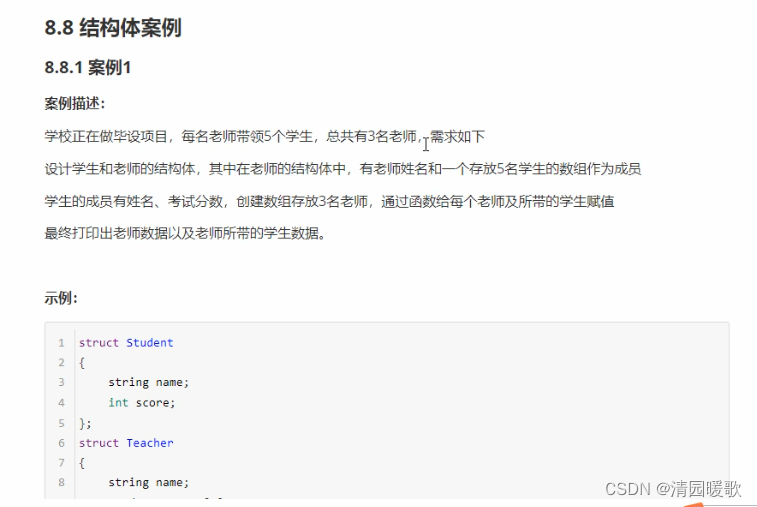

#include<iostream>
using namespace std;
#include<string>
#include<ctime>
// 学生的结构体
struct Student
{
string sName;
int score;
};
// 老师的结构体定义
struct Teacher
{
// 姓名
string tName;
// 学生数组
struct Student sArray[5];
};
// 打印所有信息
void printInfo(struct Teacher tArray[], int len)
{
for (int i = 0; i < len; i++)
{
cout << "老师姓名: " << tArray[i].tName << endl;
for (int j = 0; j < 5; j++)
{
cout << "\t学生姓名: " << tArray[i].sArray[j].sName
<< " 考试分数: "<< tArray[i].sArray[j].score << endl;
}
}
}
// 给老师和学生赋值的函数
void allocateSpace(Teacher tArray[], int len)
{
string nameSeed = "ABCDE";
for (int i = 0; i < len; i++)
{
tArray[i].tName = "Teacher_";
tArray[i].tName += nameSeed[i];
// 通过循环给每名老师所带的学生赋值
for (int j = 0; j < 5; j++)
{
tArray[i].sArray[j].sName = "Student_";
tArray[i].sArray[j].sName += nameSeed[j];
int random = rand() % 61 + 40; // 40 ~ 100
tArray[i].sArray[j].score = random;
}
}
}
int main()
{
// 随机数种子
srand((unsigned int)time(NULL));
// 1、创建3名老师的数组
struct Teacher tArray[3];
// 2、通过函数给3名老师的信息赋值,并给老师带的学生信息赋值
int len = sizeof(tArray) / sizeof(tArray[0]);
allocateSpace(tArray, len);
// 3、打印所有老师及所带的学生信息
printInfo(tArray, len);
system("pause");
return 0;
}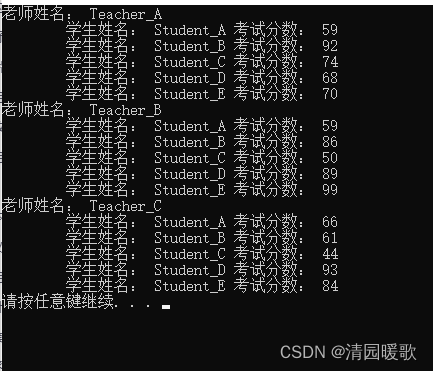
8.8.2 案例2

#include<iostream>
using namespace std;
#include<string>
#include<ctime>
// 1、设计英雄结构体
// 英雄结构体
struct Hero
{
// 姓名
string name;
// 年龄
int age;
// 性别
string sex;
};
// 冒泡排序 实现年龄的升序排序
void bubbleSort(struct Hero heroArray[], int len)
{
for (int i = 0; i < len - 1; i++)
{
for (int j = 0; j < len - 1; j++)
{
// 如果j 下标的元素年龄 大于 j+1下标元素的年龄 , 交换两个元素
if (heroArray[j].age > heroArray[j + 1].age)
{
struct Hero temp = heroArray[j];
heroArray[j] = heroArray[j + 1];
heroArray[j + 1] = temp;
}
}
}
}
// 打印排序后数组中的信息
void printHero(struct Hero heroArray[], int len)
{
for (int i = 0; i < len; i++)
{
cout << "姓名: " << heroArray[i].name << " 年龄: " << heroArray[i].age
<< " 性别: " << heroArray[i].sex << endl;
}
}
int main()
{
// 随机数种子
srand((unsigned int)time(NULL));
// 2、创建数组存放5名英雄
struct Hero heroArray[5] =
{
{"刘备", 23, "男"},
{"关羽", 22, "男"},
{"张飞", 20, "男"},
{"赵云", 21, "男"},
{"貂蝉", 19, "女"}
};
int len = sizeof(heroArray) / sizeof(heroArray[0]);
cout << "排序前的结果:" << endl;
for (int i = 0; i < len; i++)
{
cout << "姓名: " << heroArray[i].name << " 年龄: " << heroArray[i].age
<< " 性别: " << heroArray[i].sex << endl;
}
// 3、对数组进行排序,按照年龄进行升序排序
bubbleSort(heroArray, len);
cout << "排序后的结果:" << endl;
// 4、将排序后结果输出
printHero(heroArray, len);
system("pause");
return 0;
}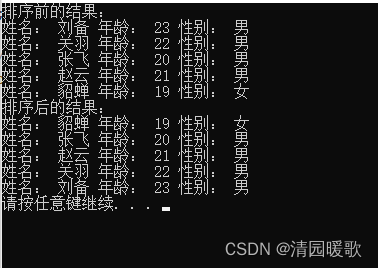






















 2730
2730











 被折叠的 条评论
为什么被折叠?
被折叠的 条评论
为什么被折叠?










